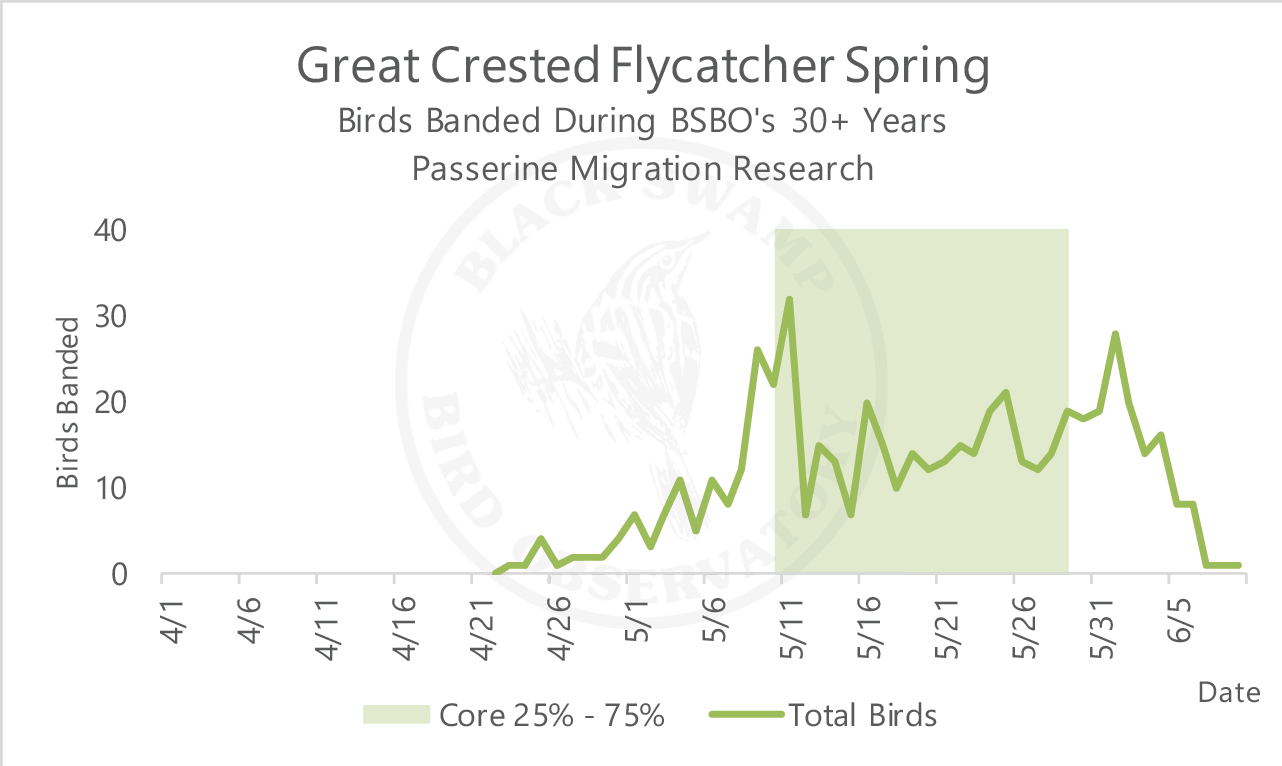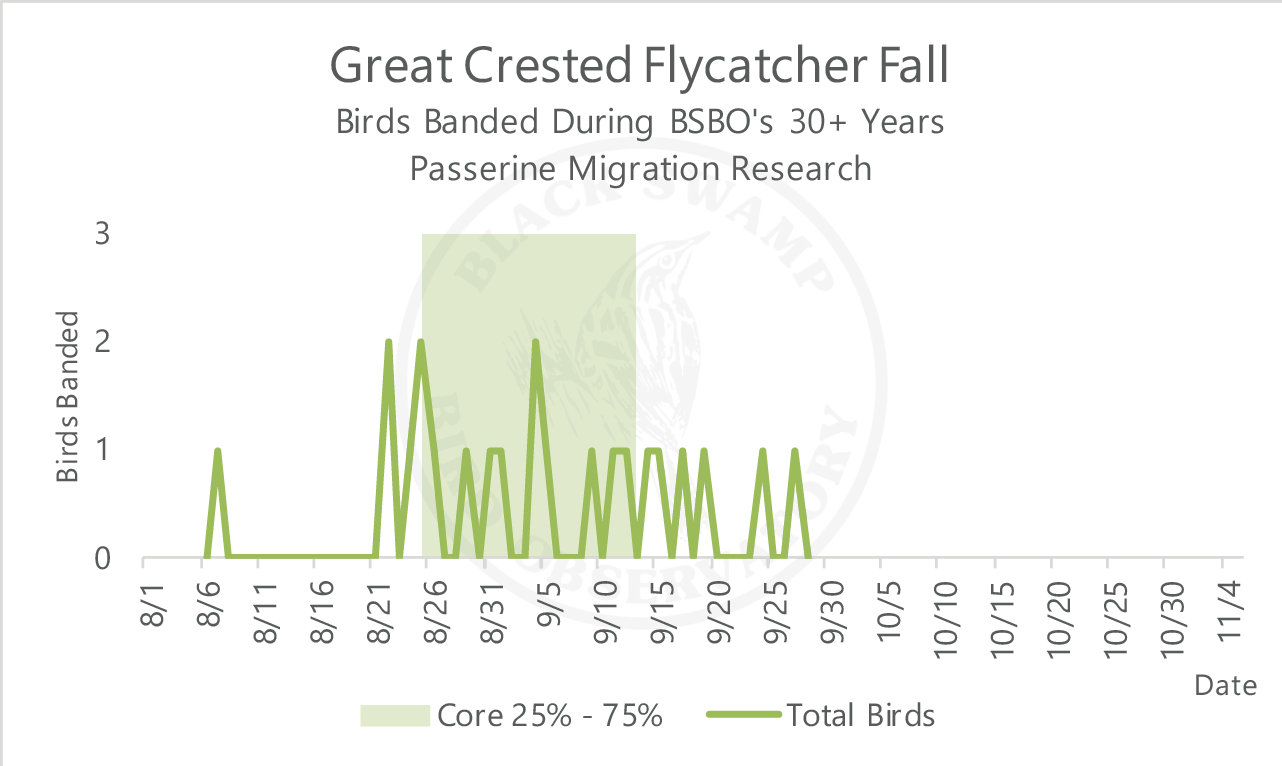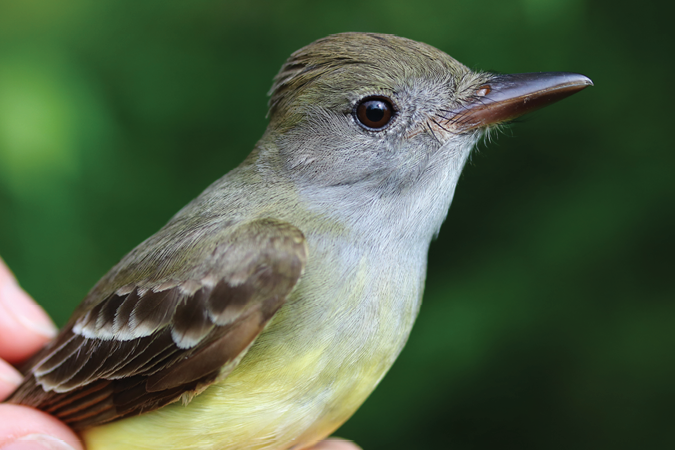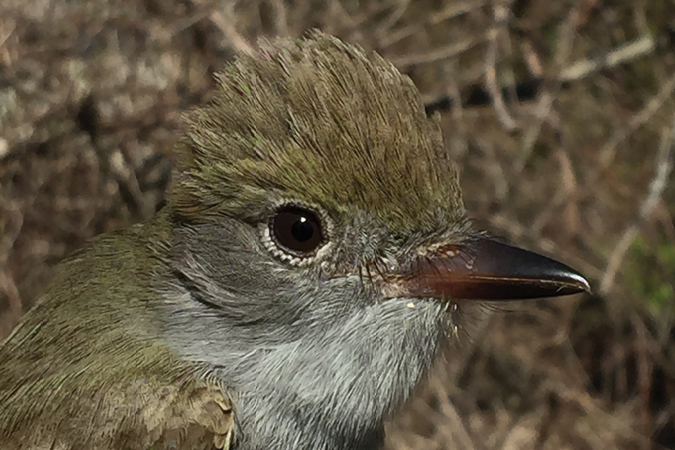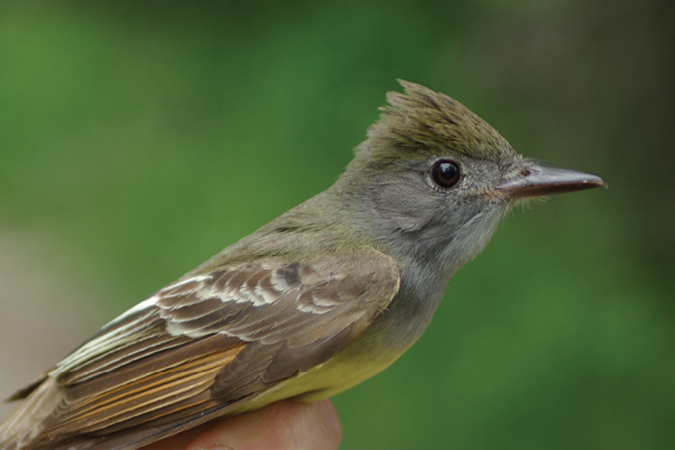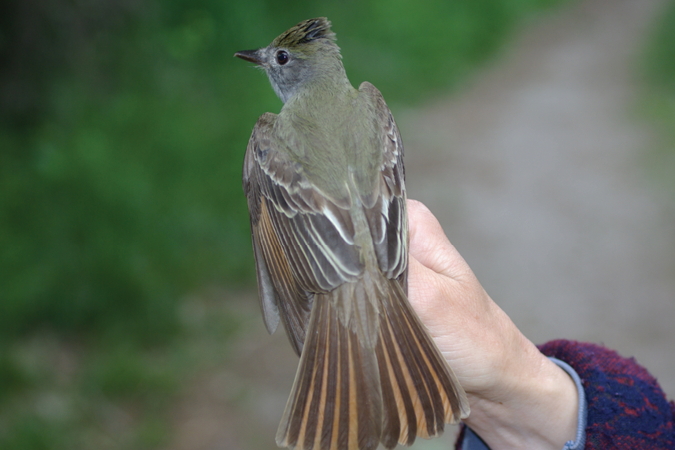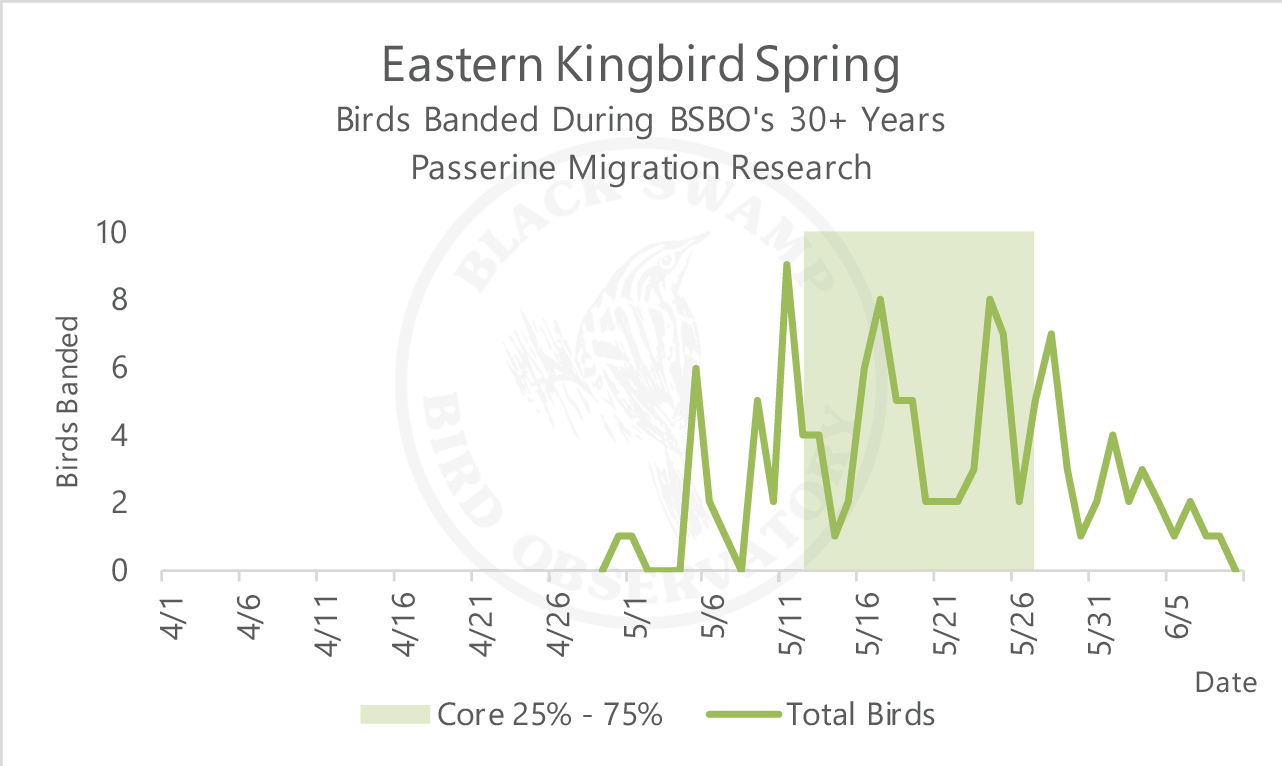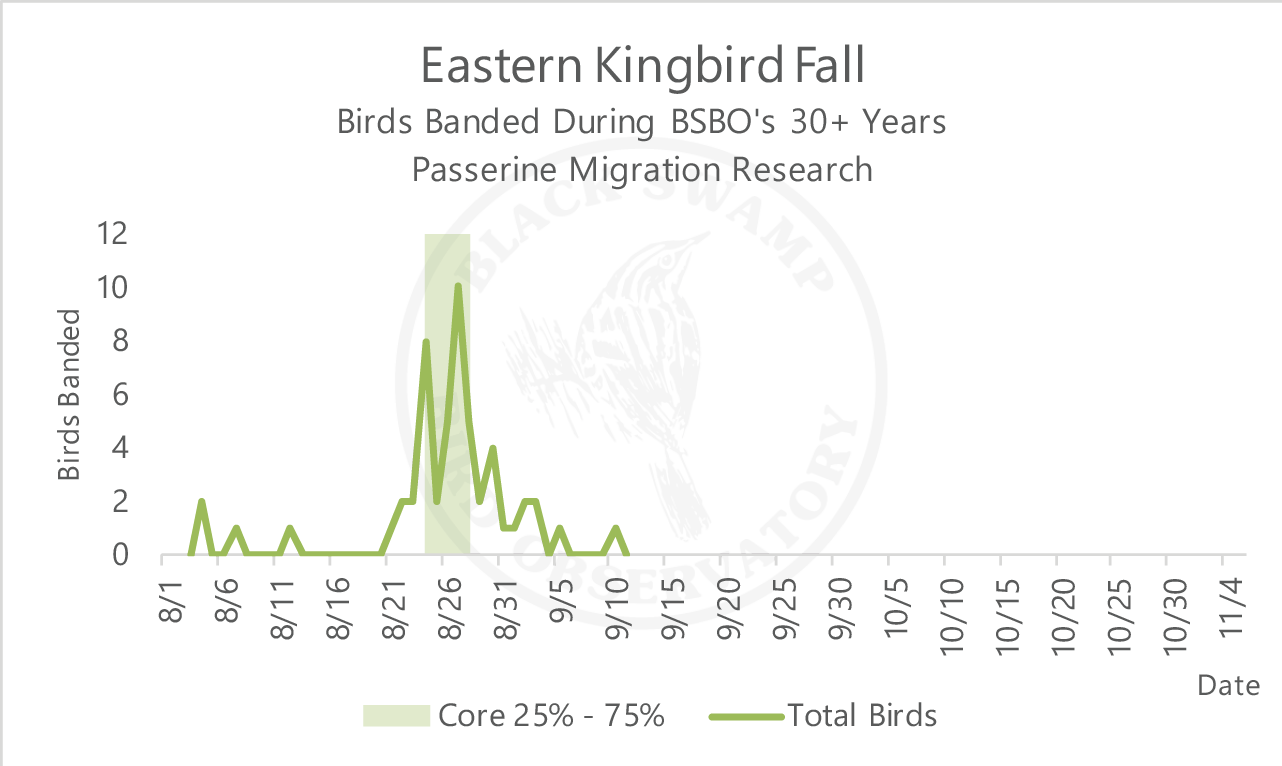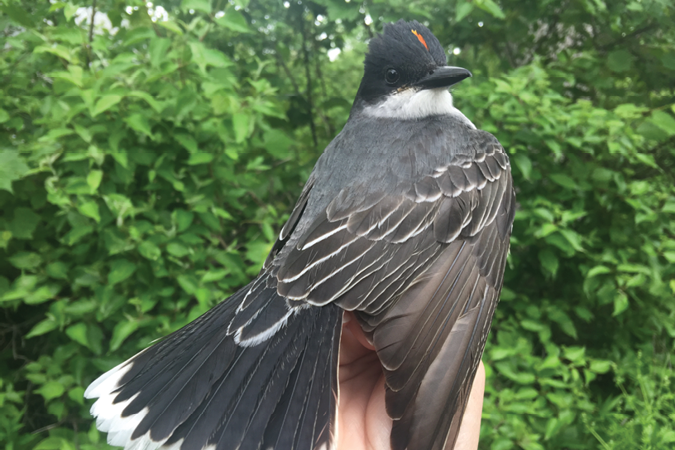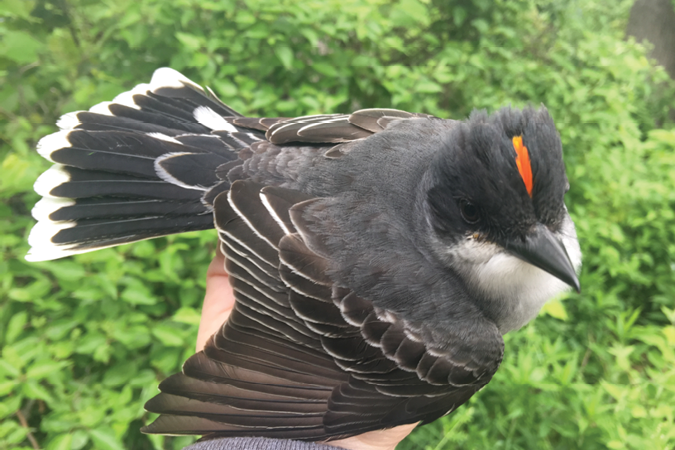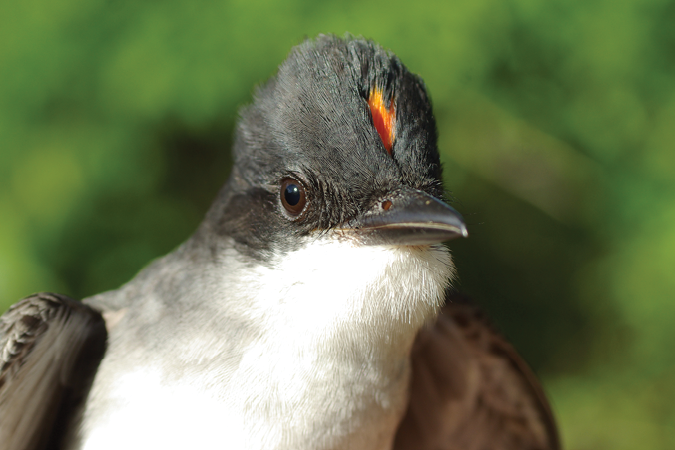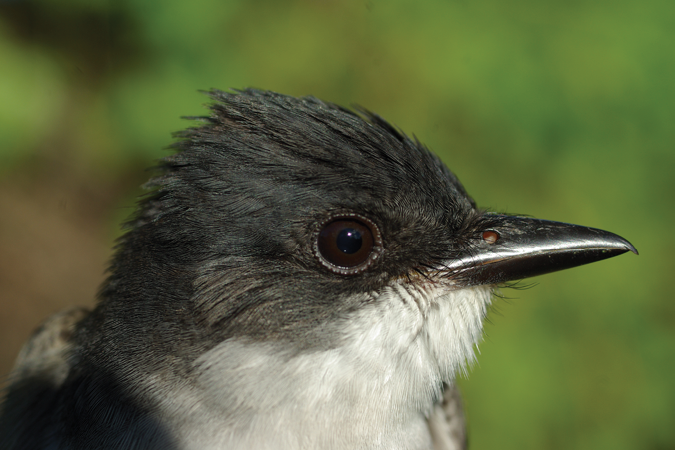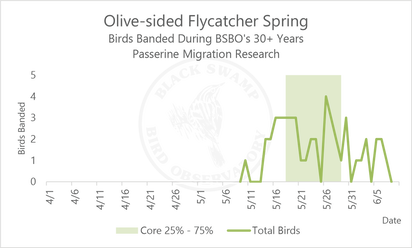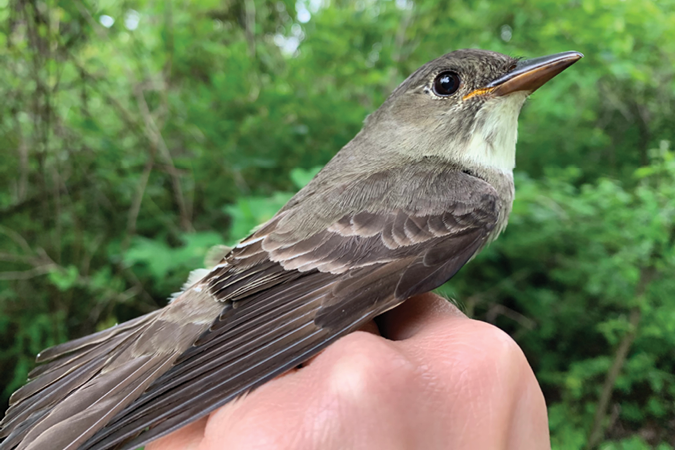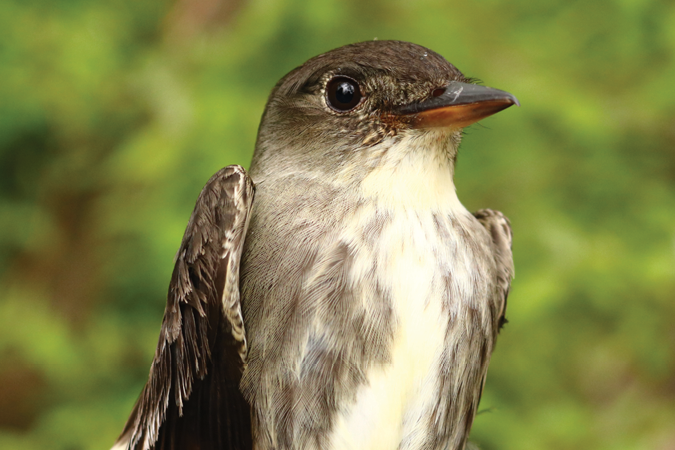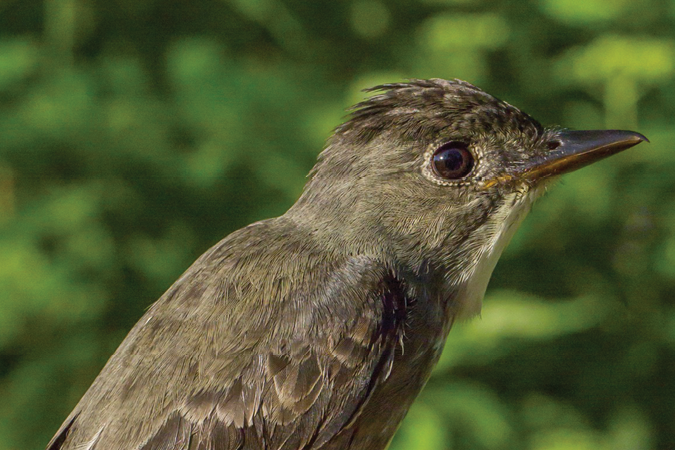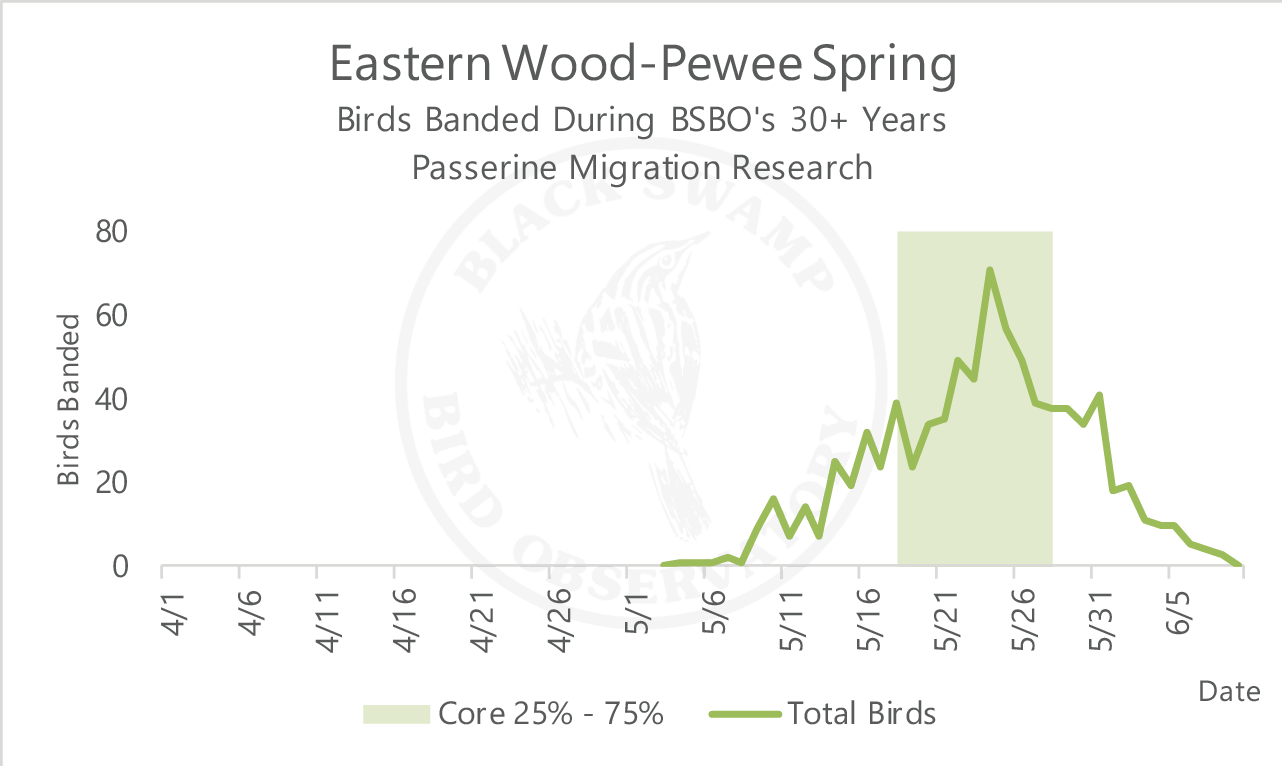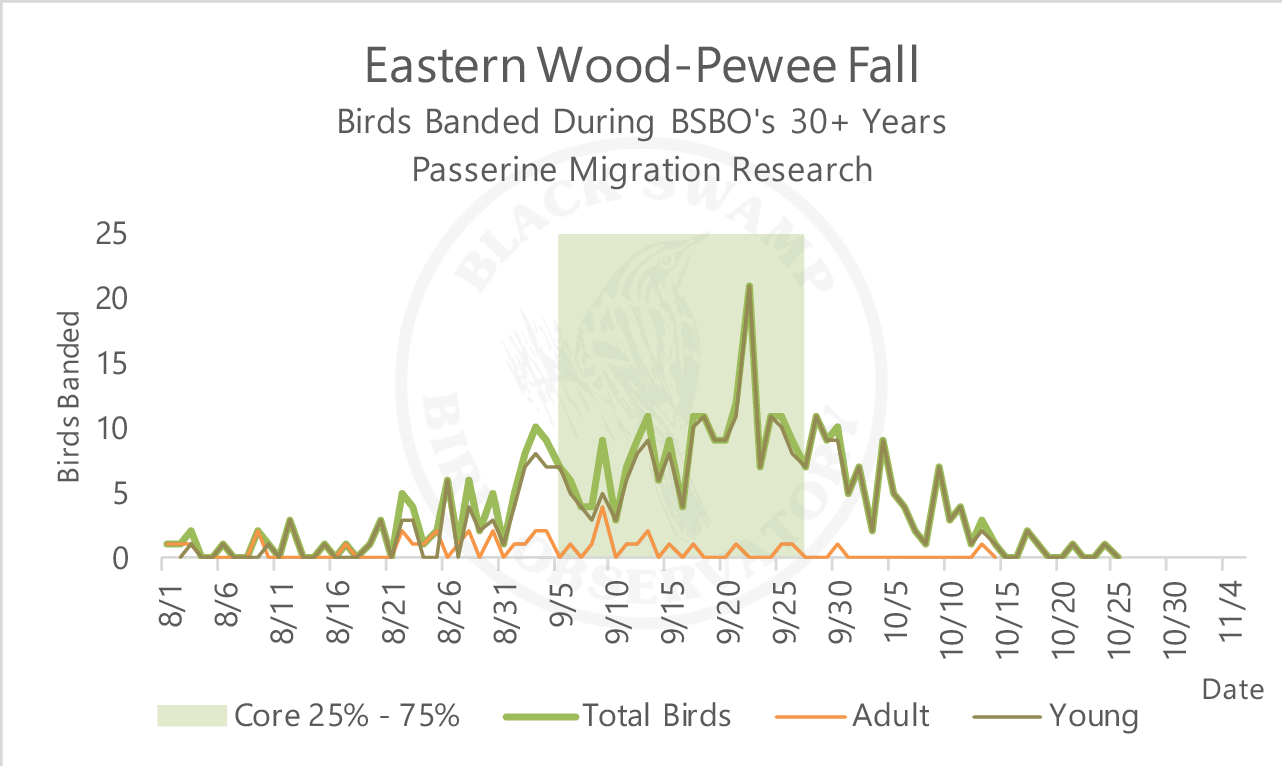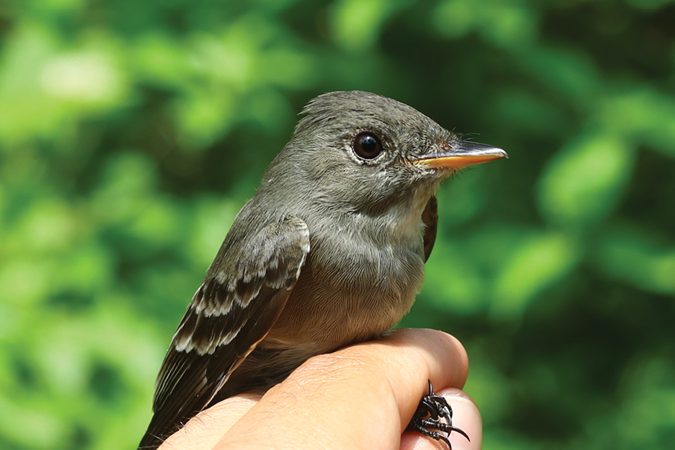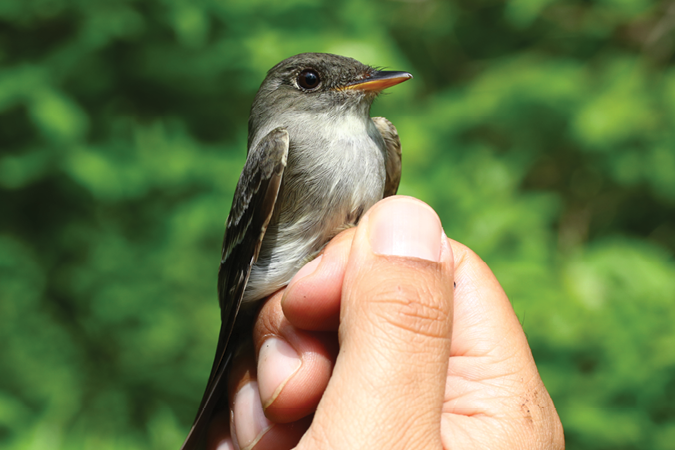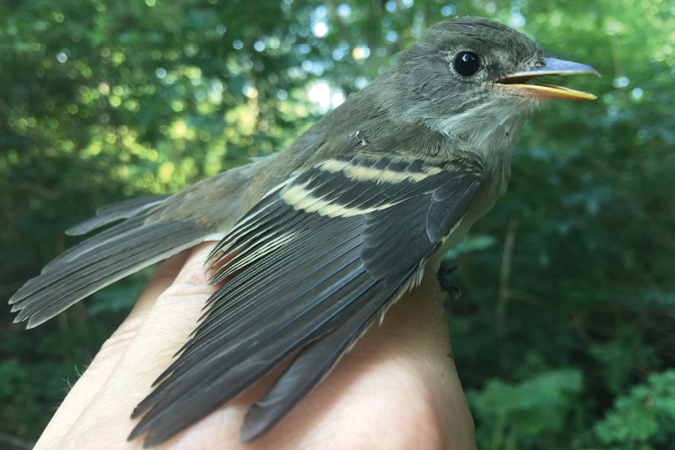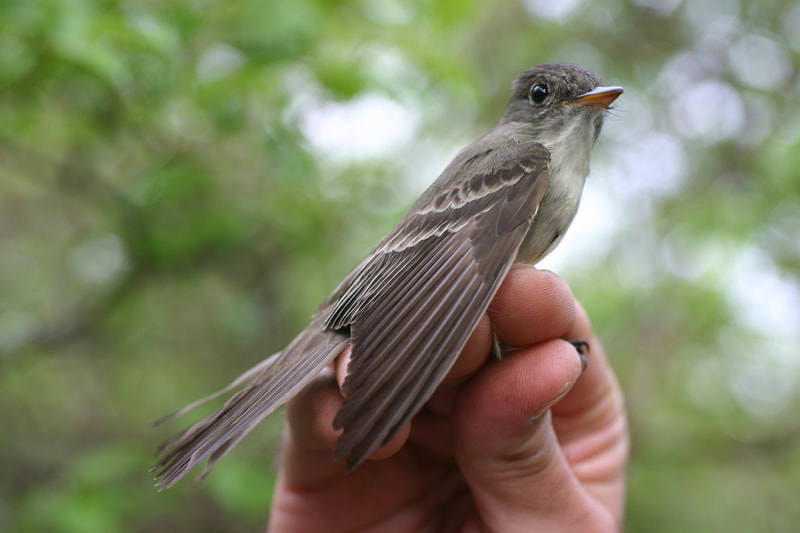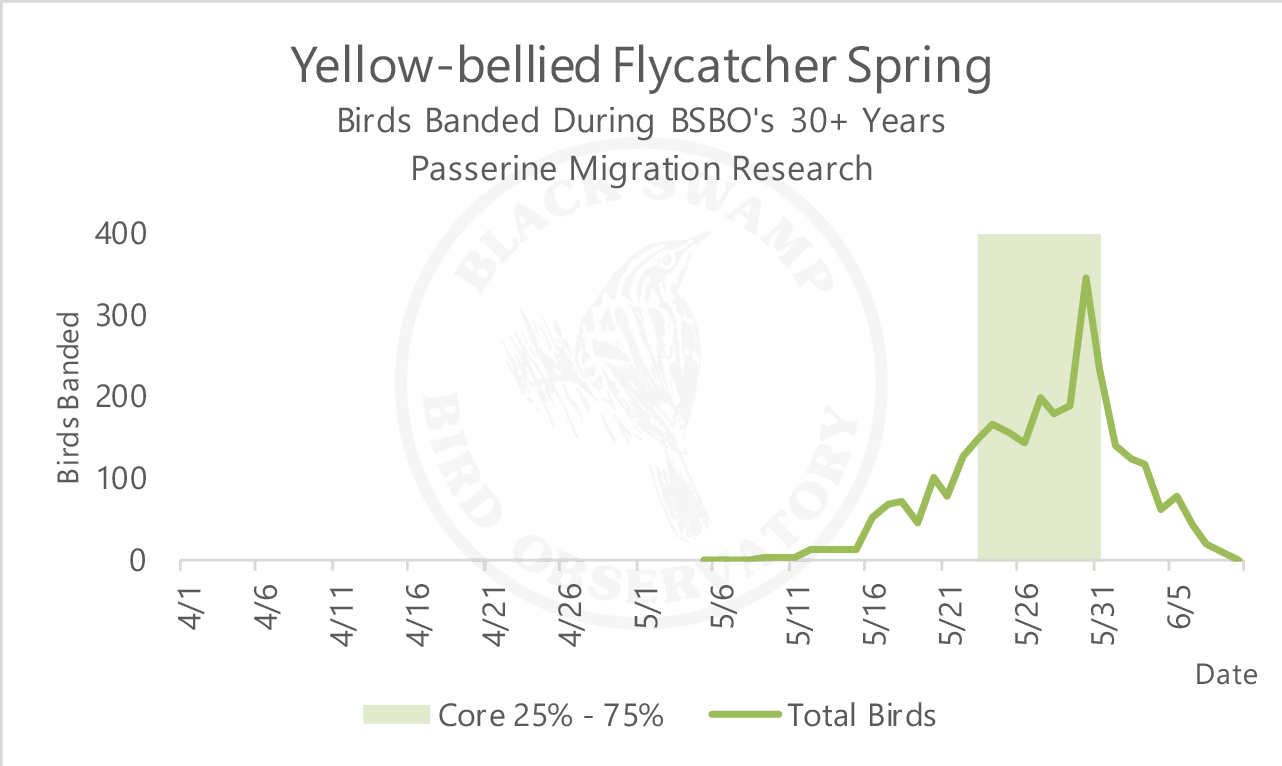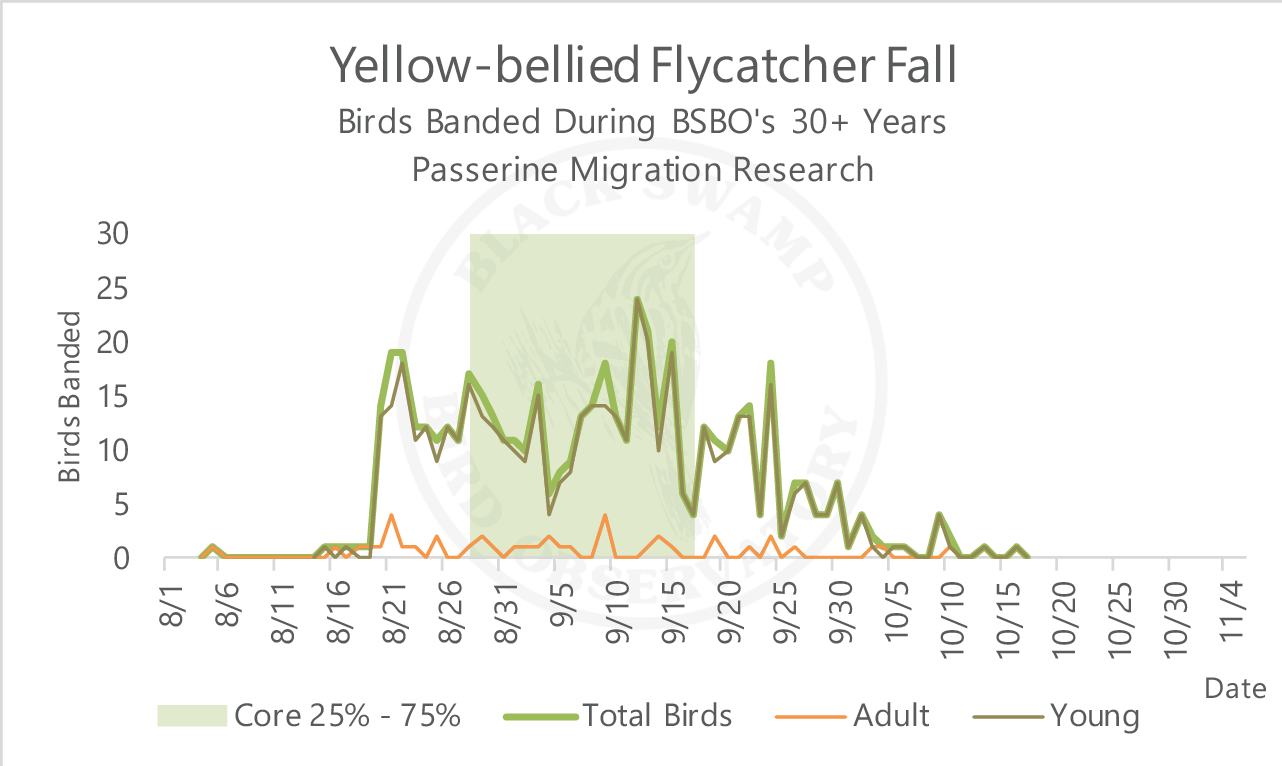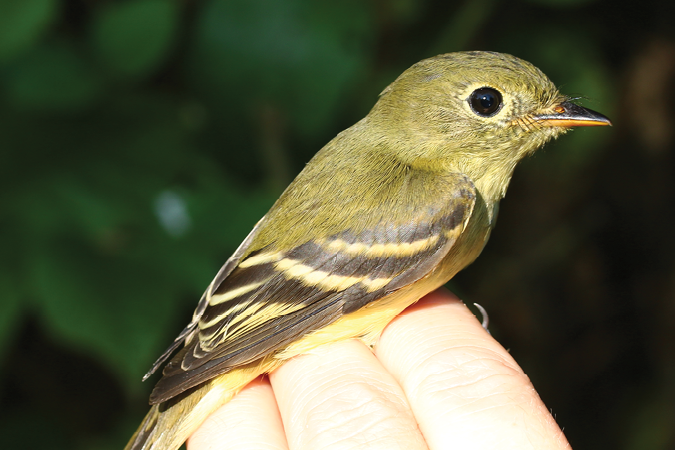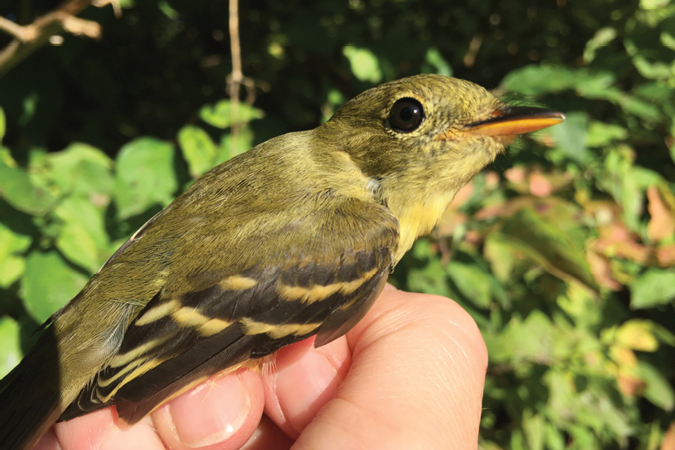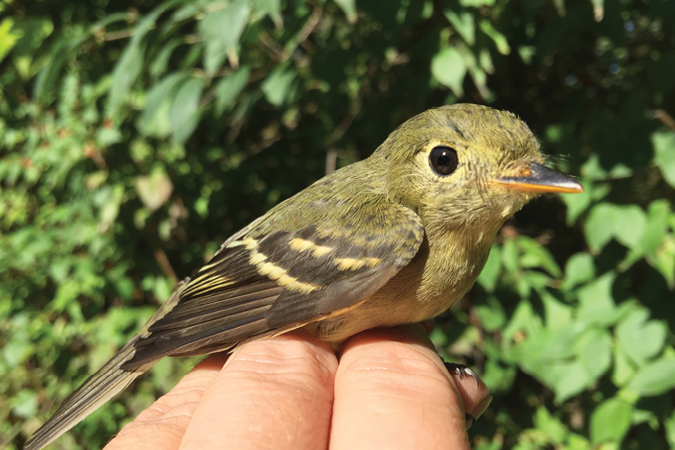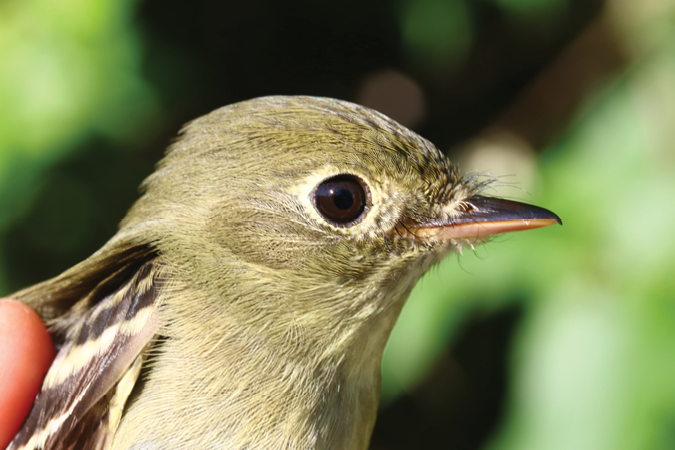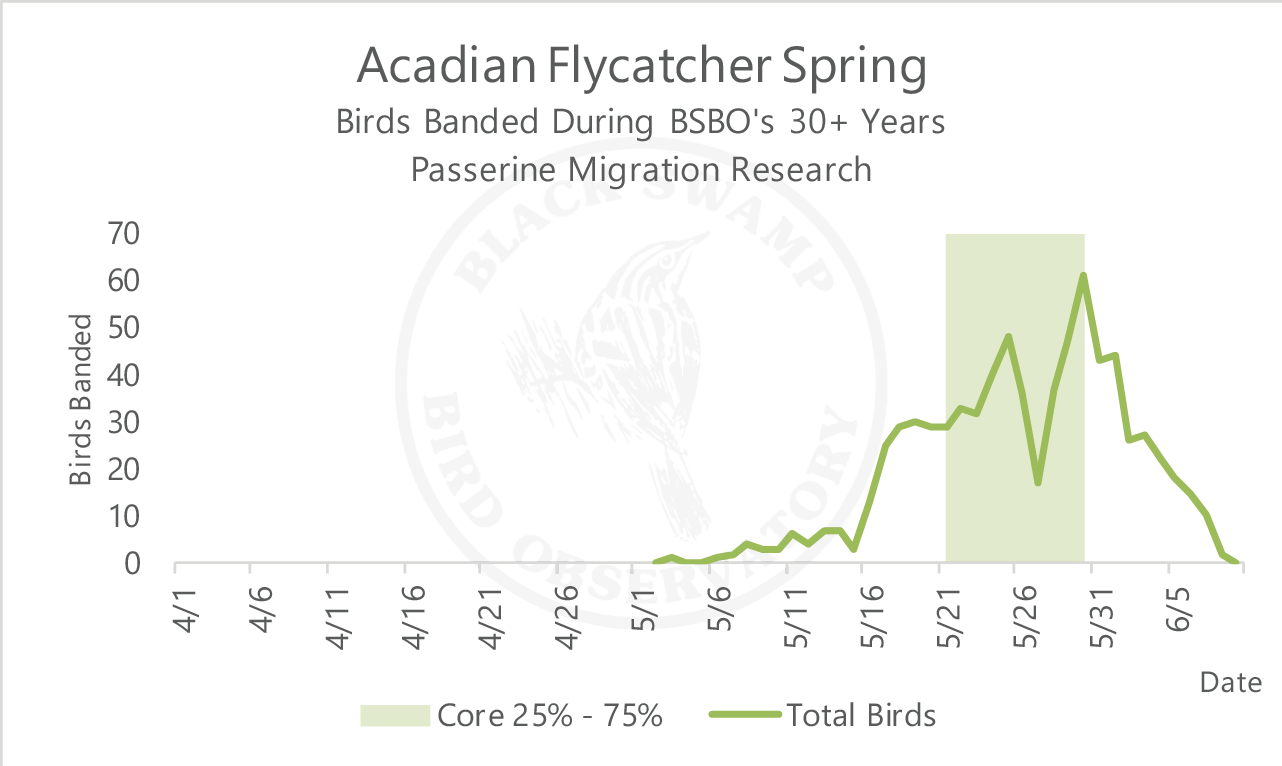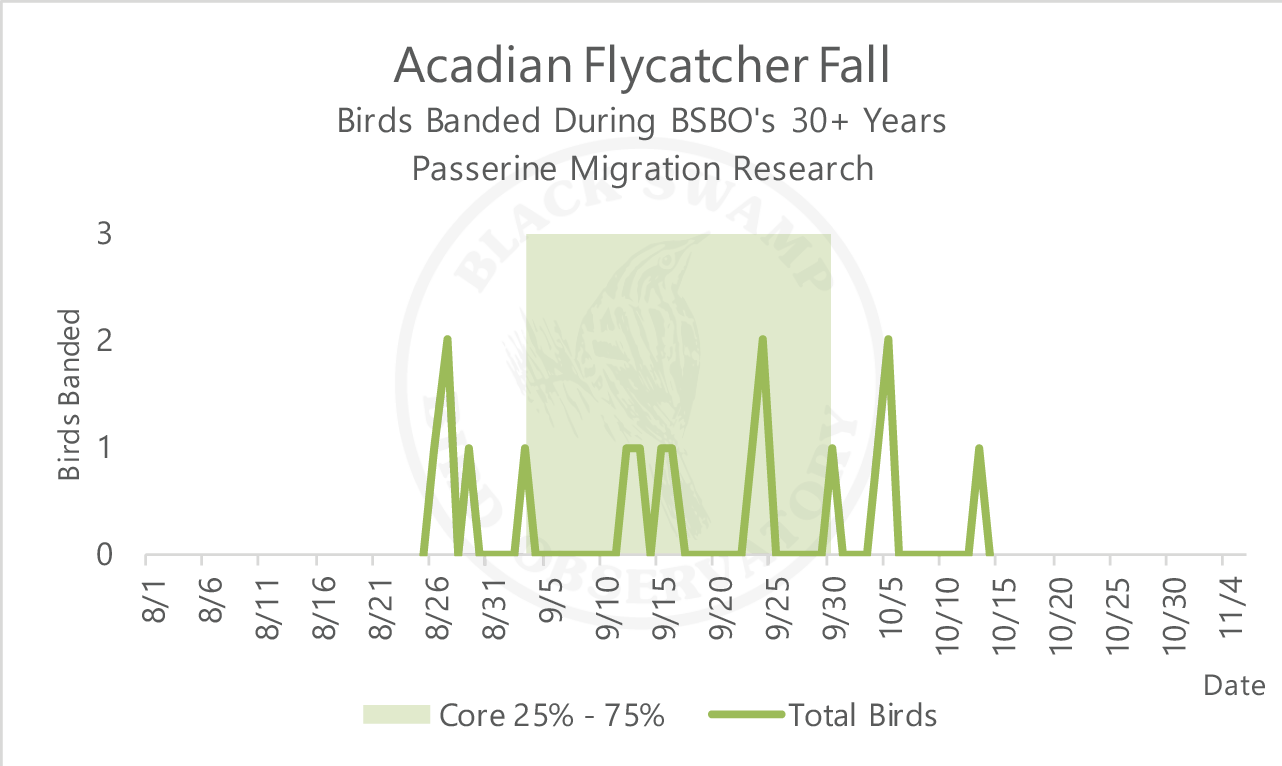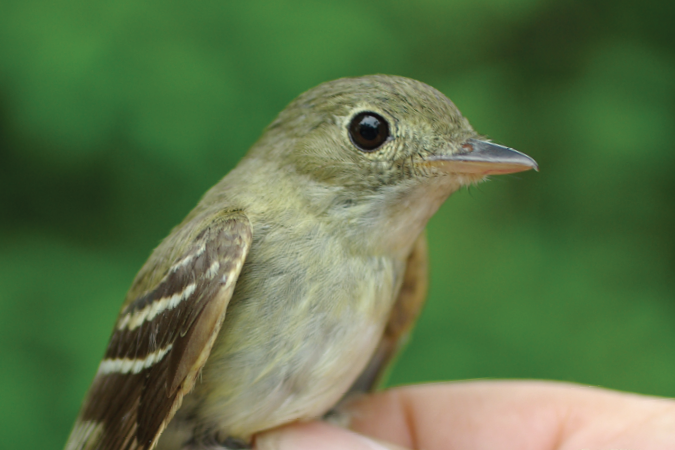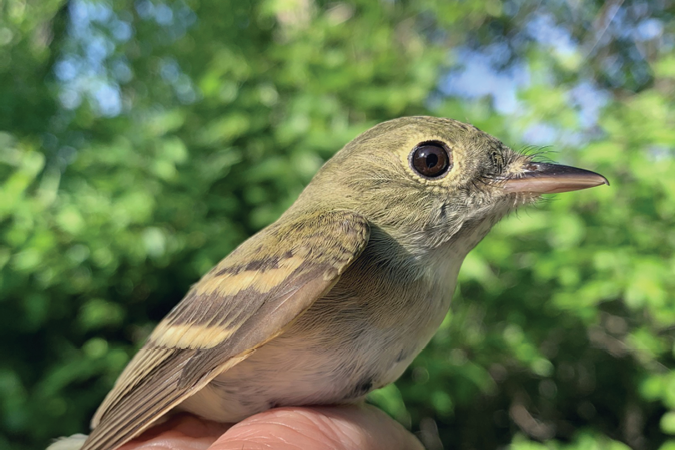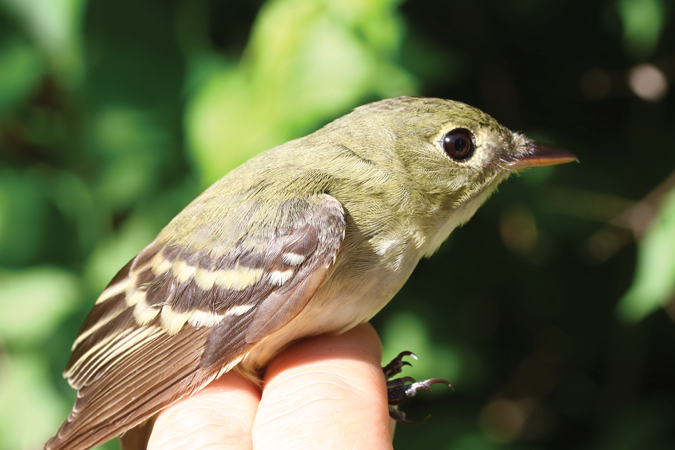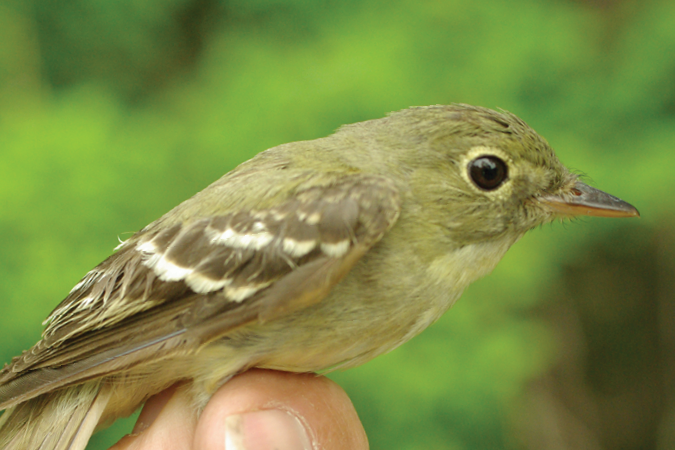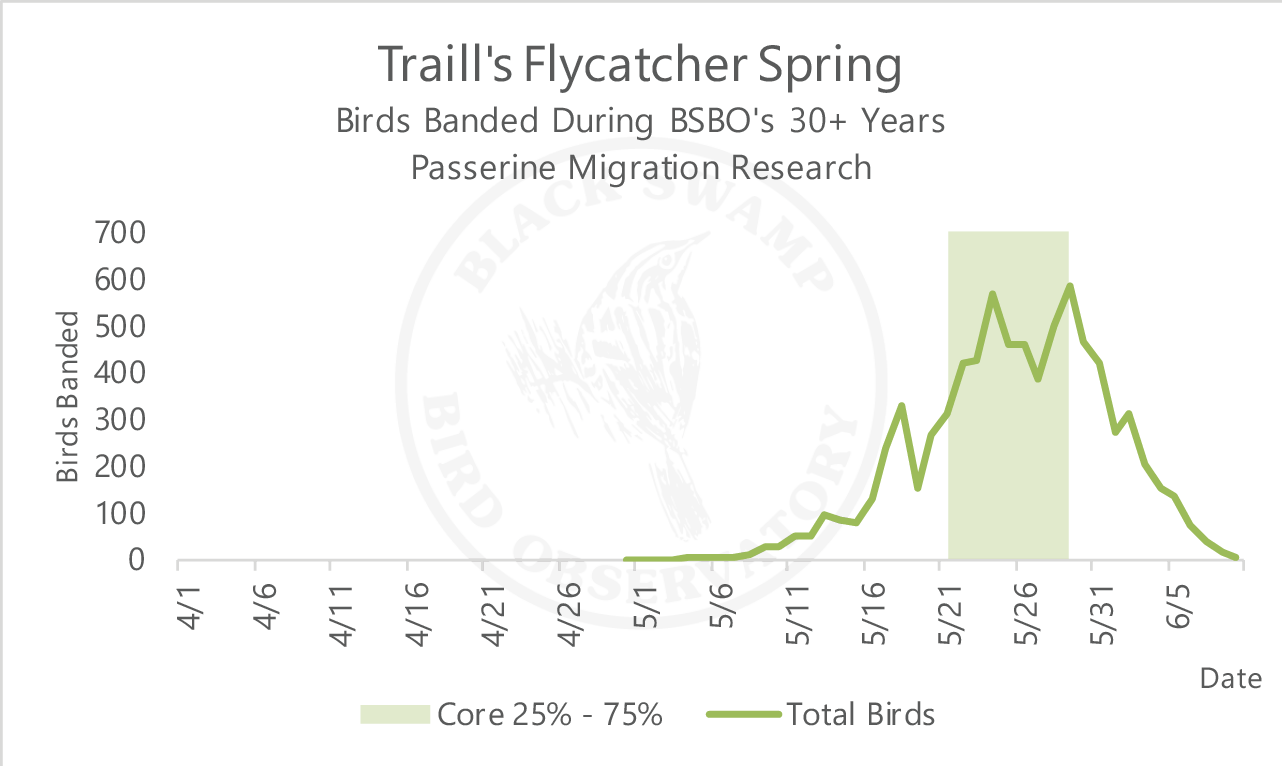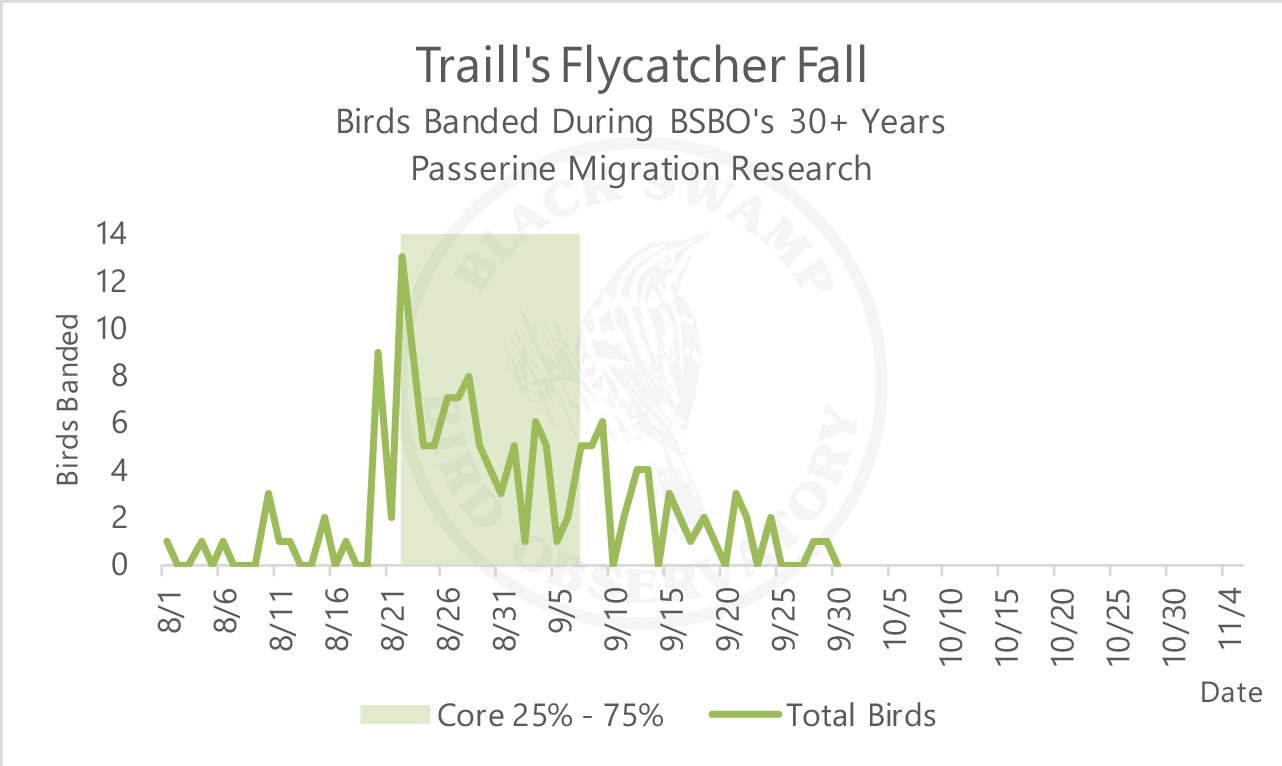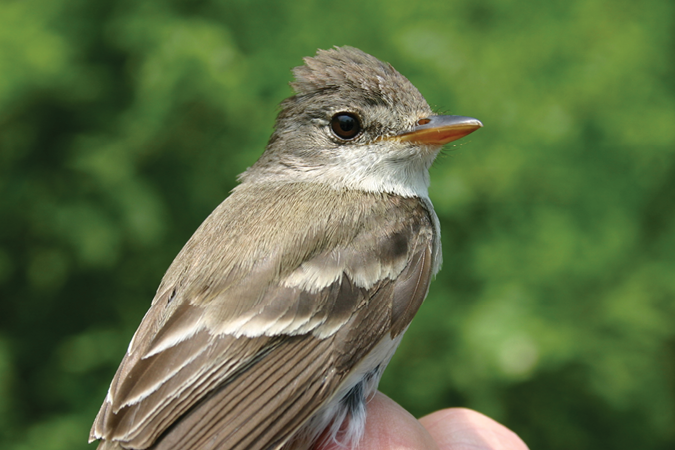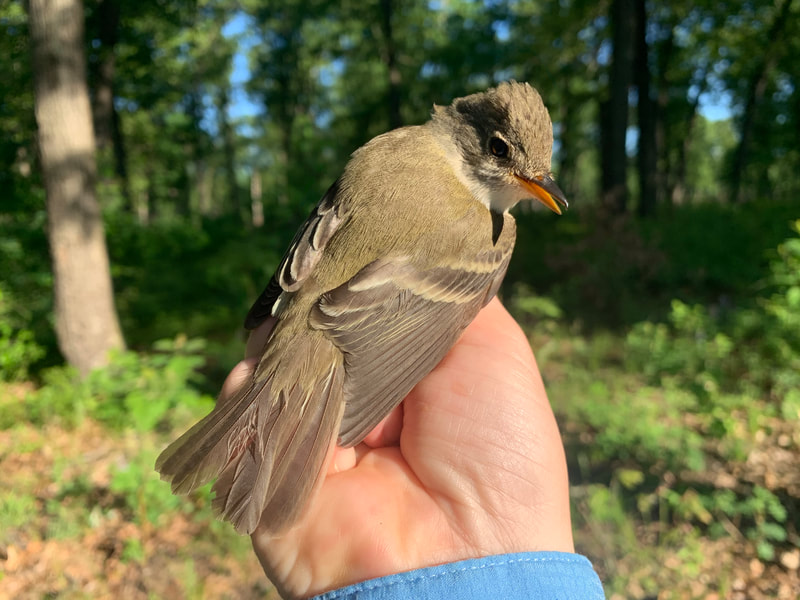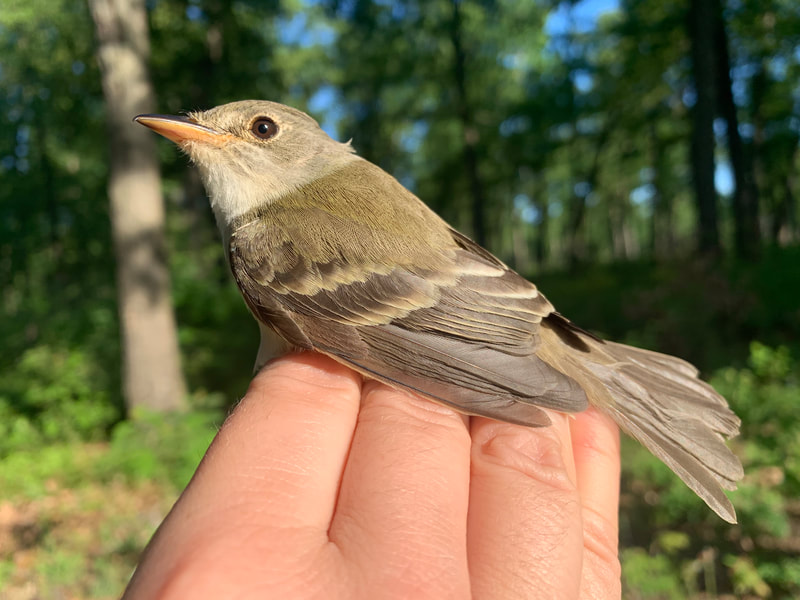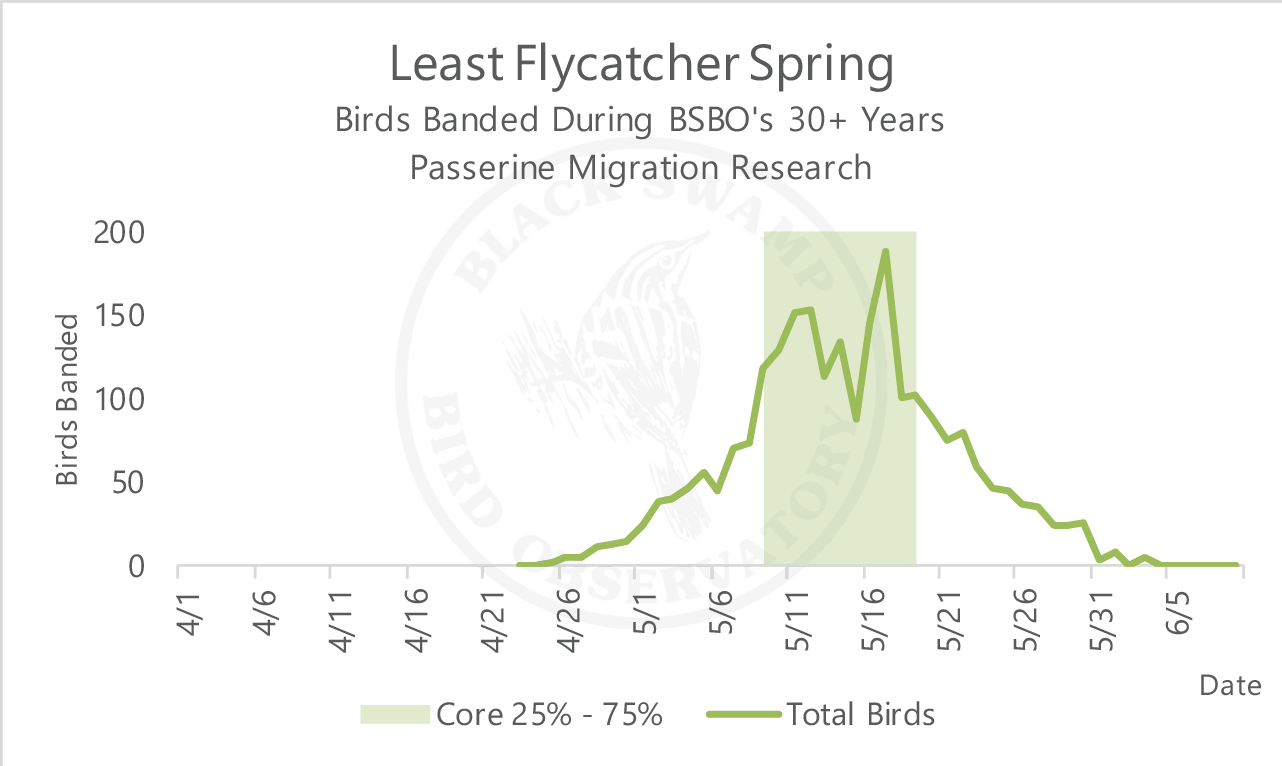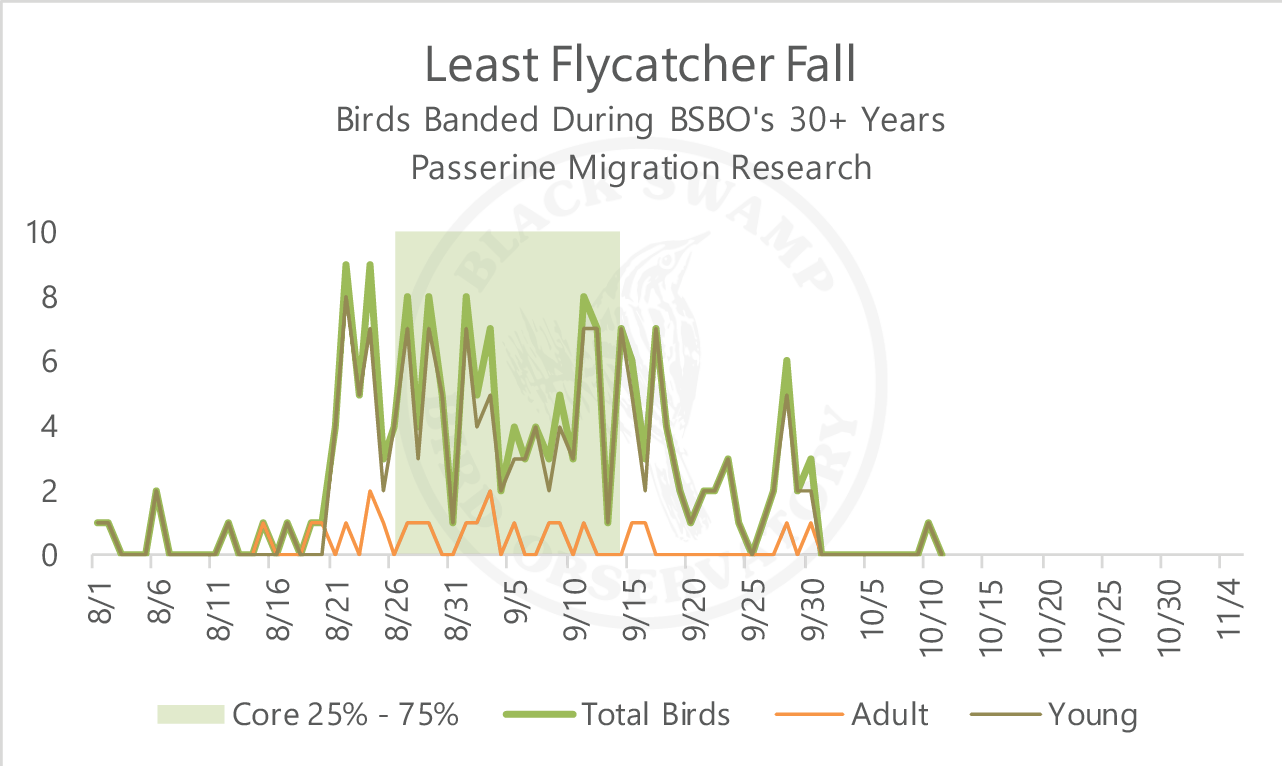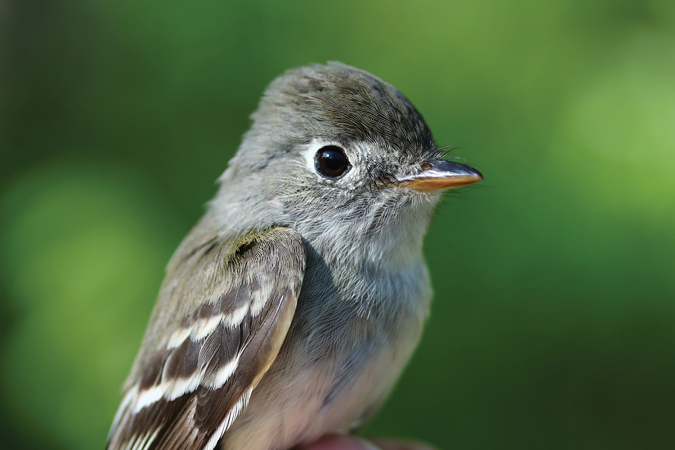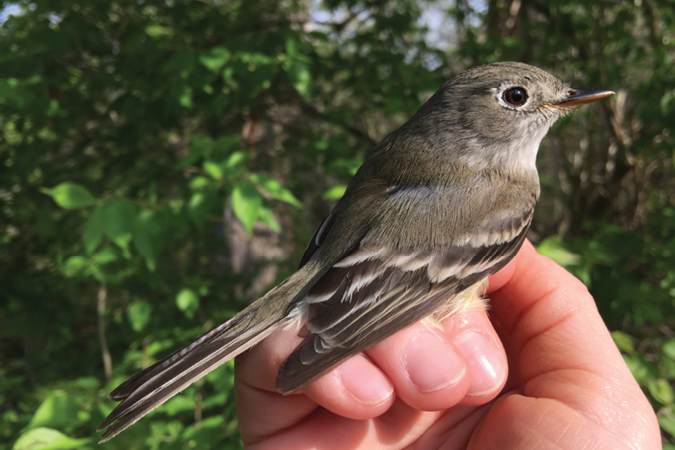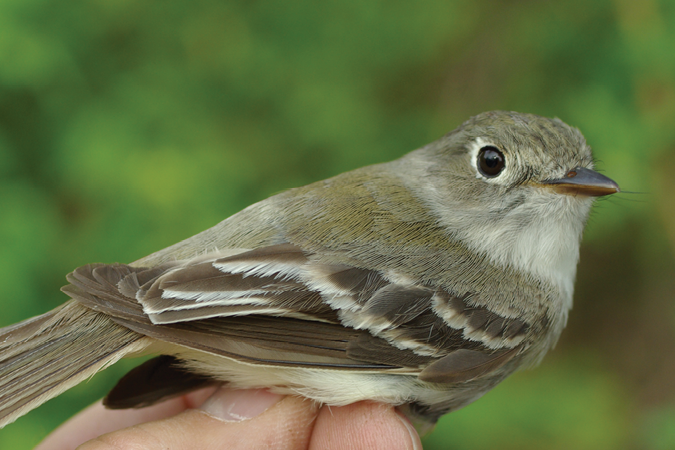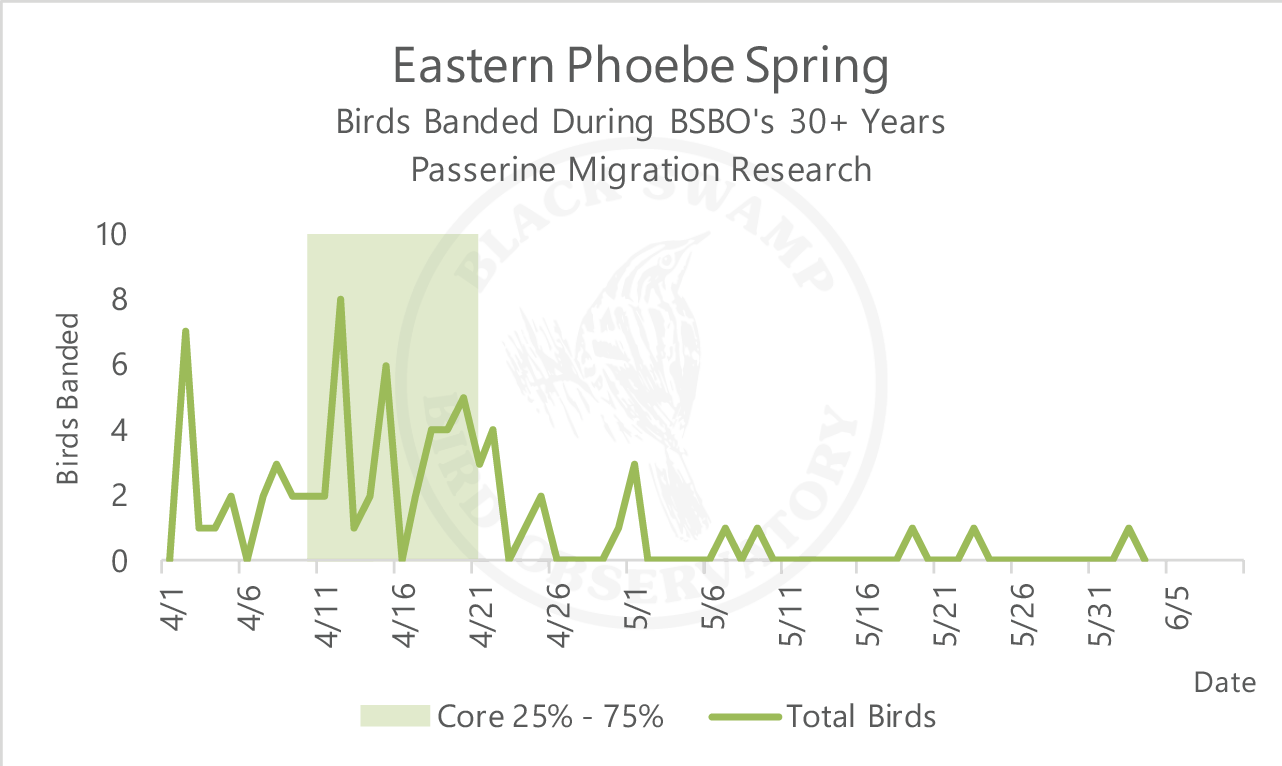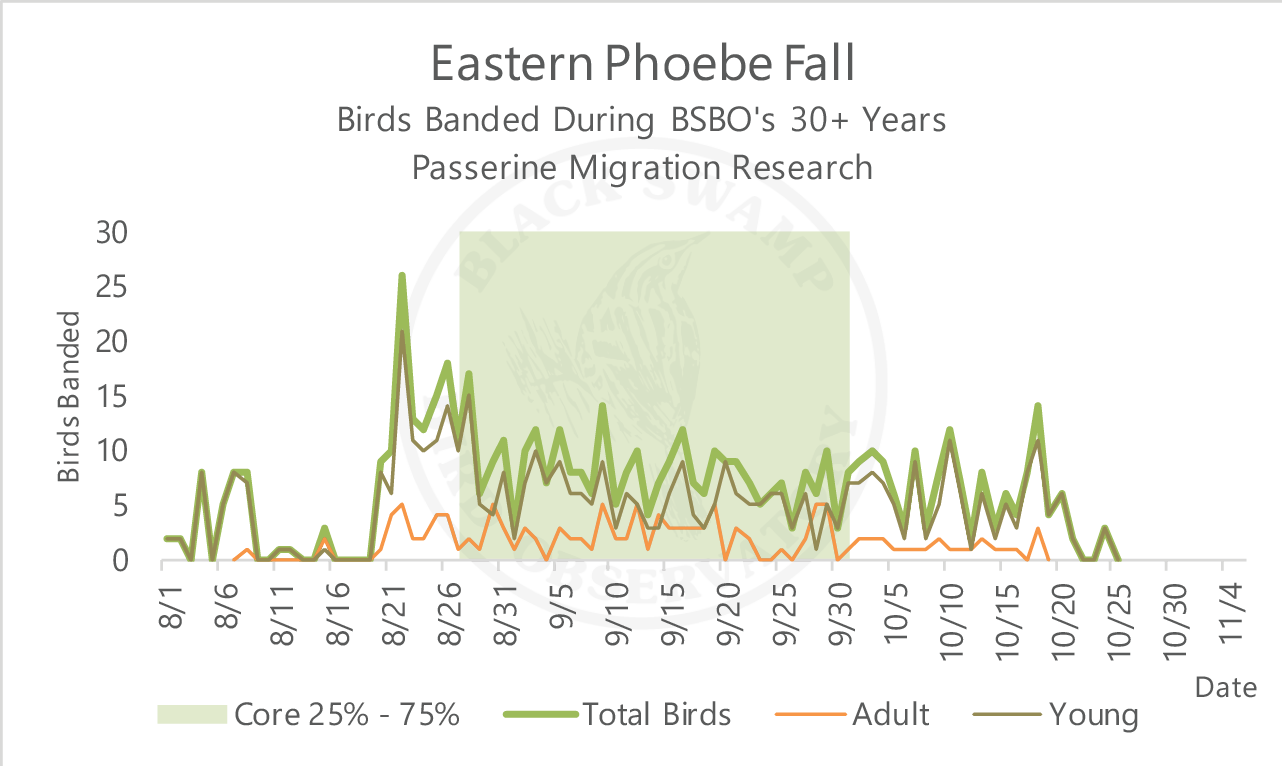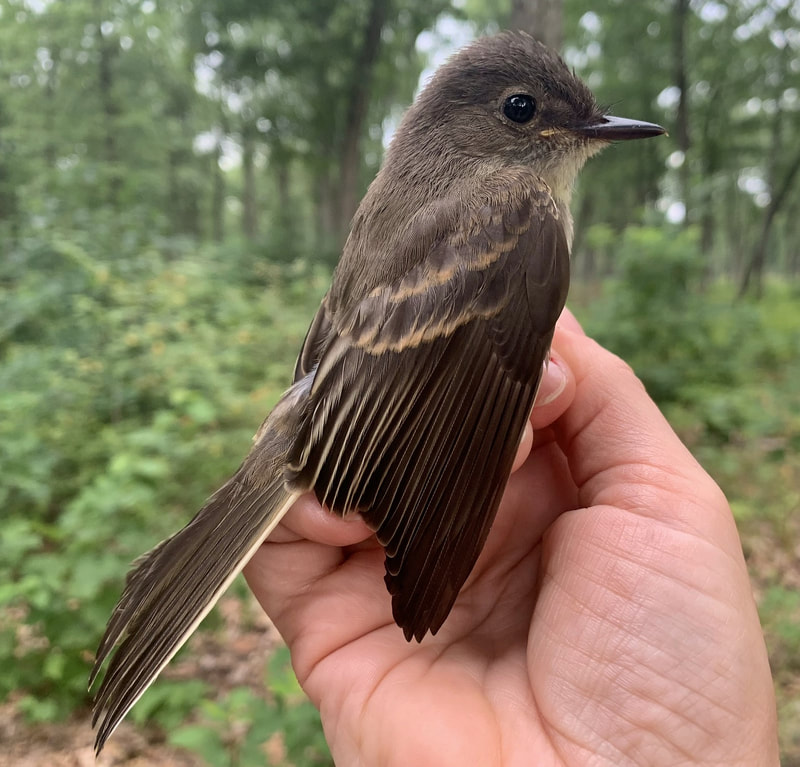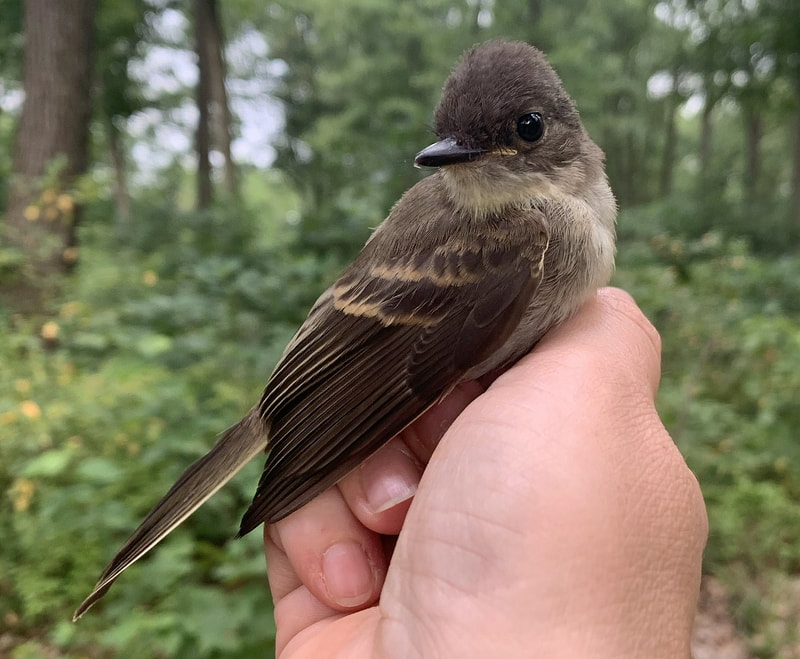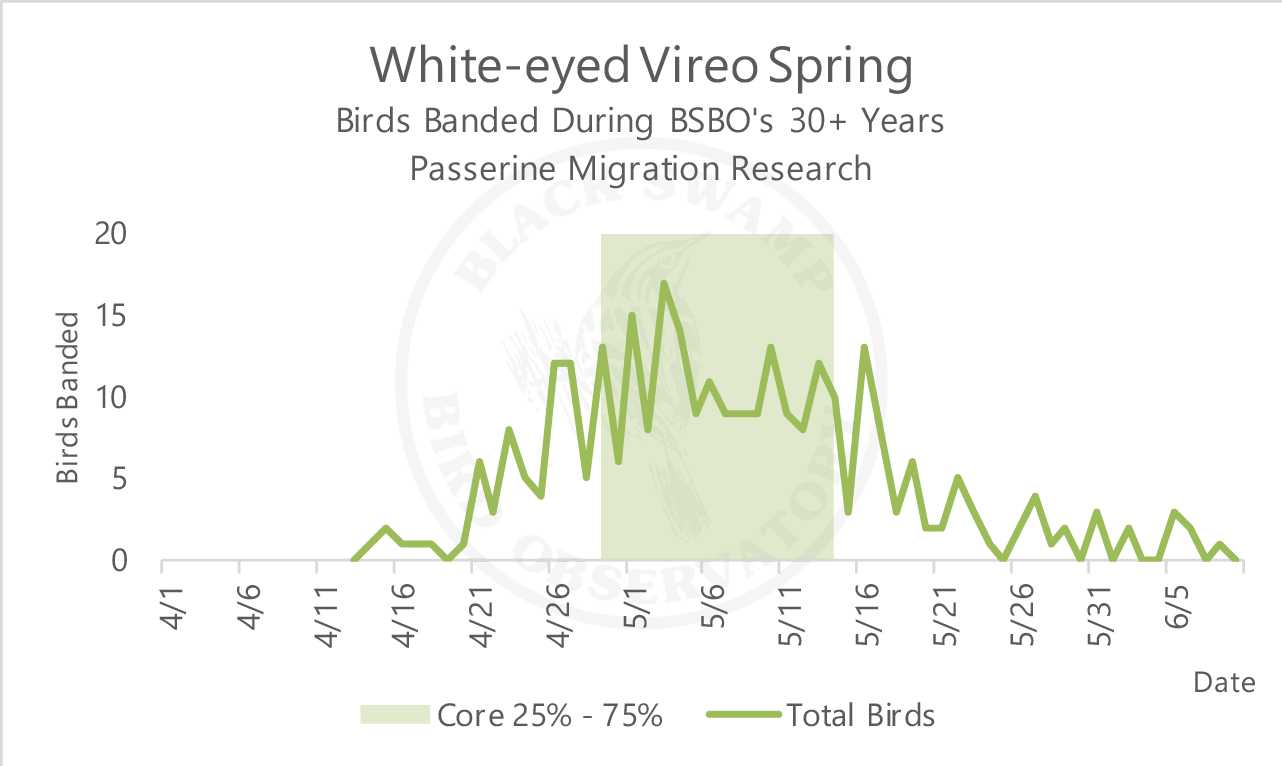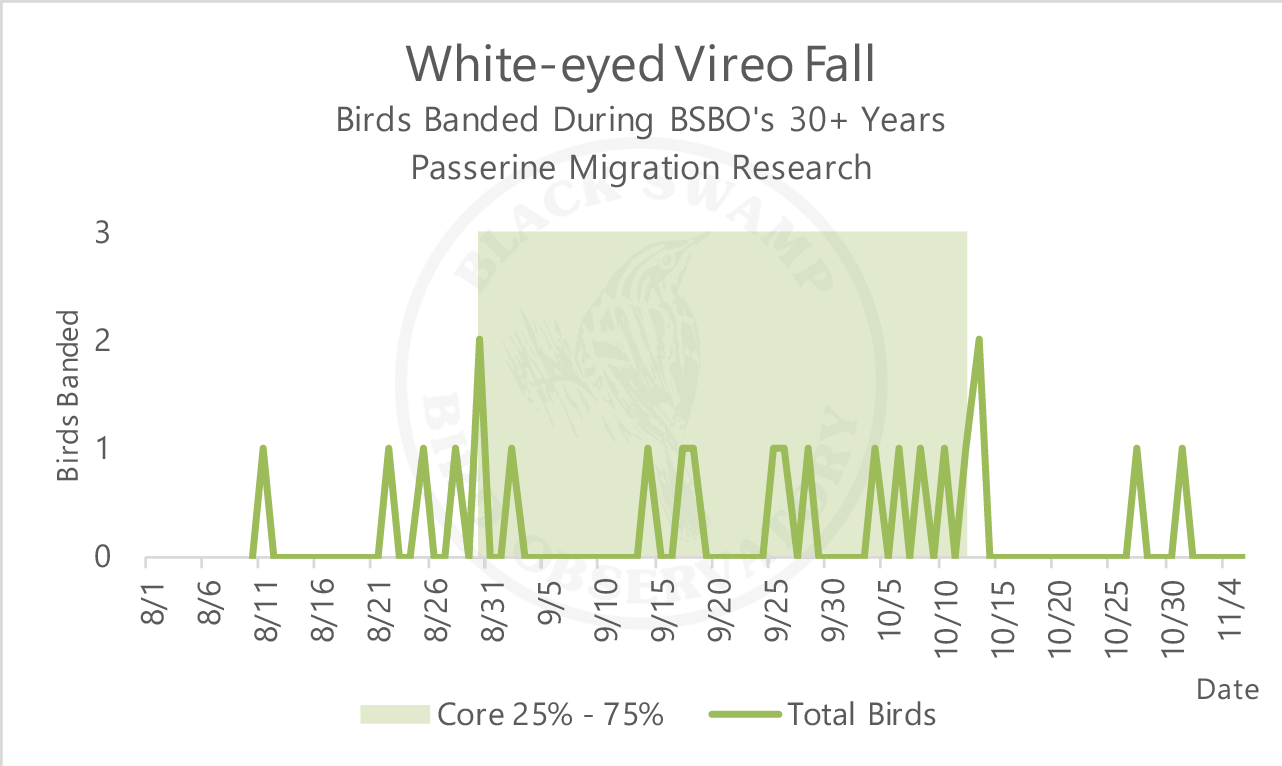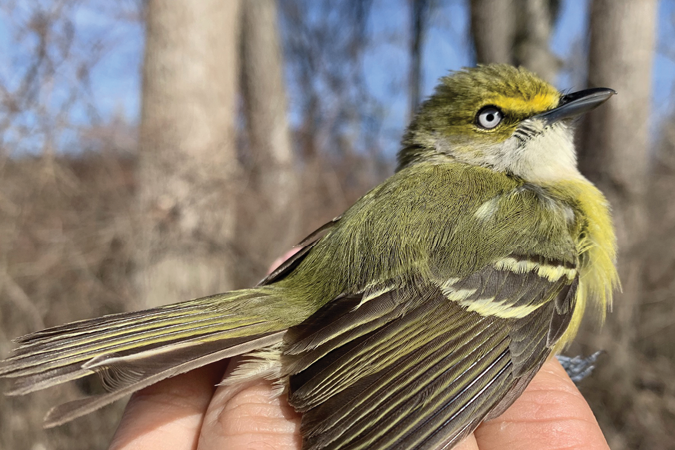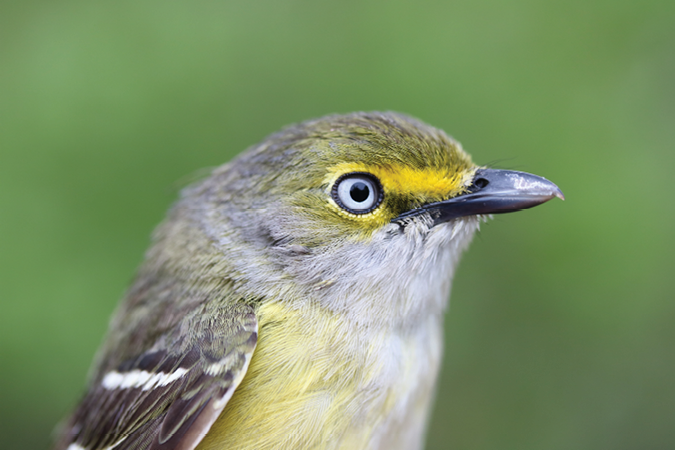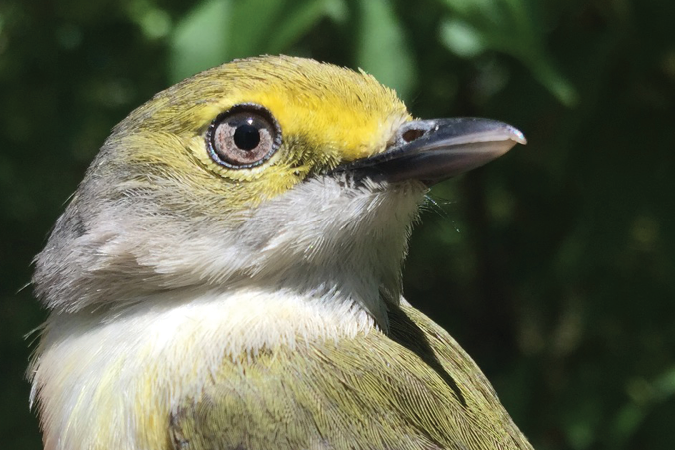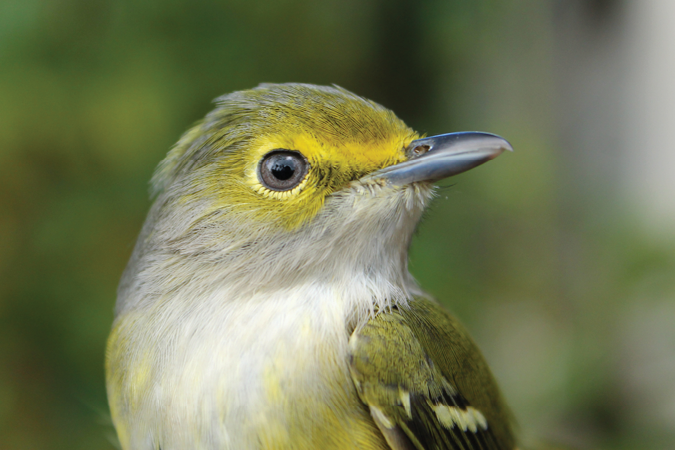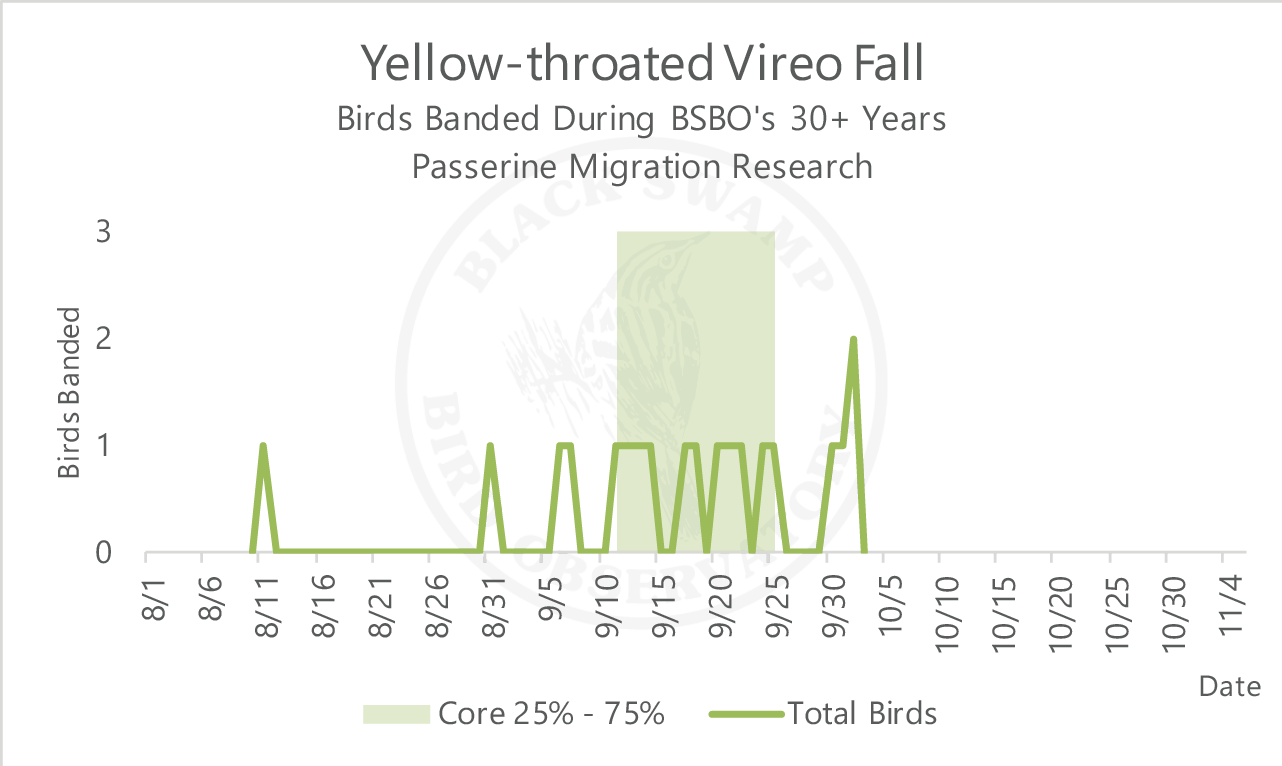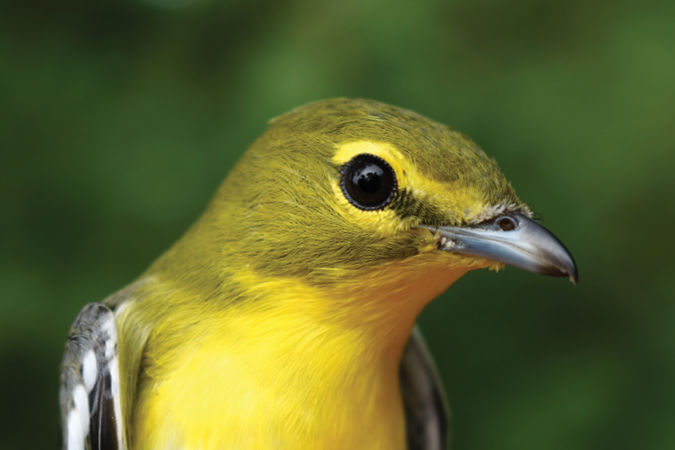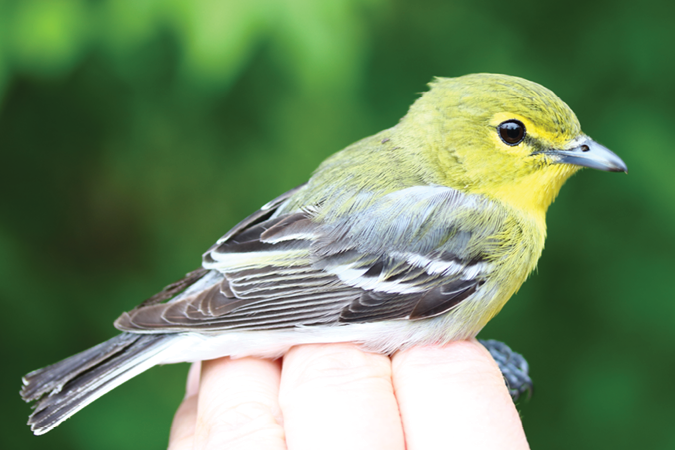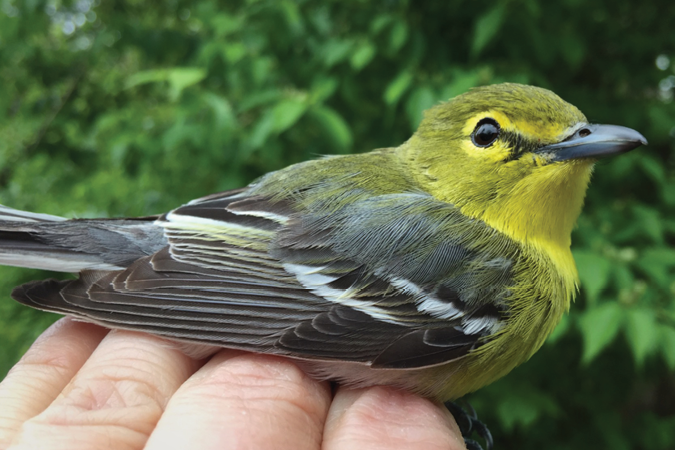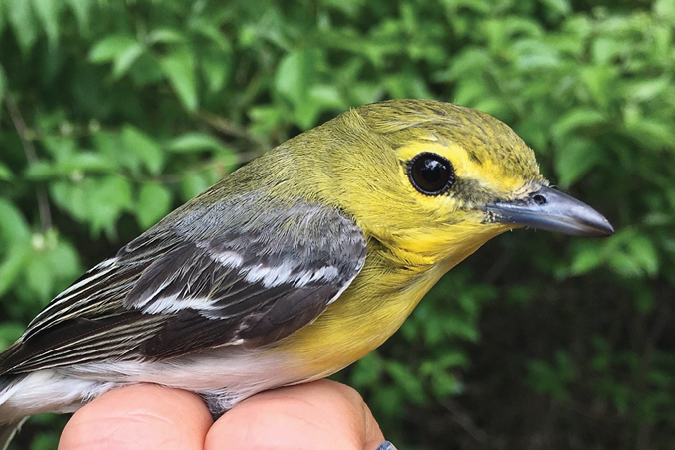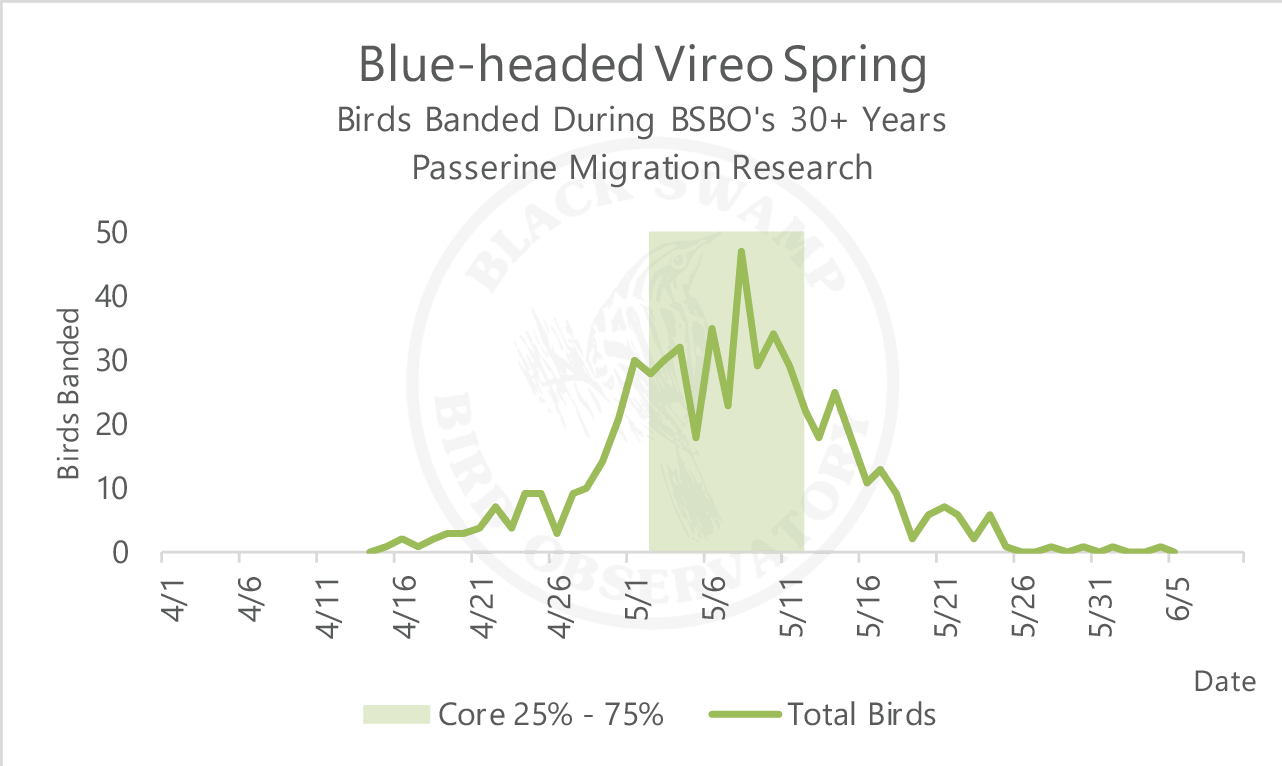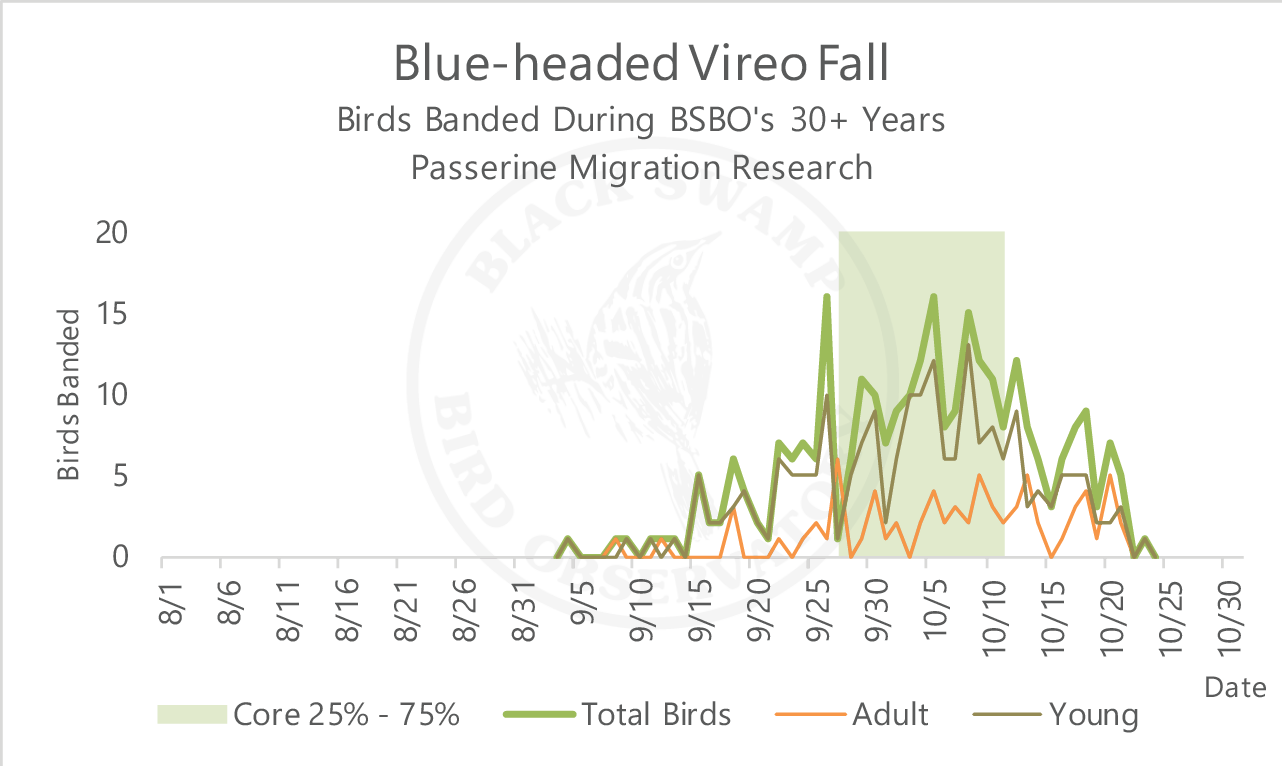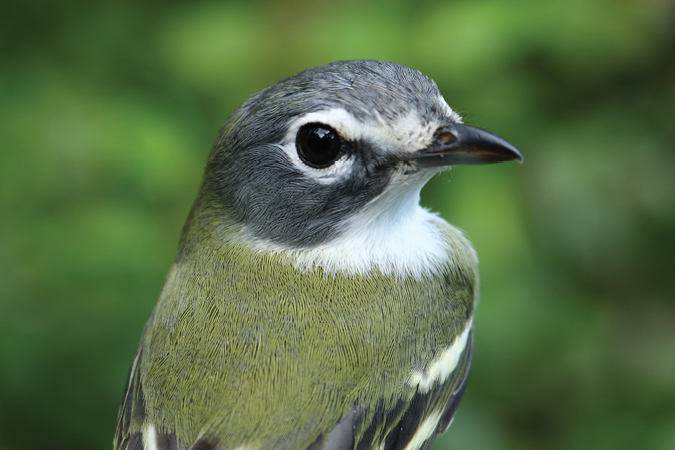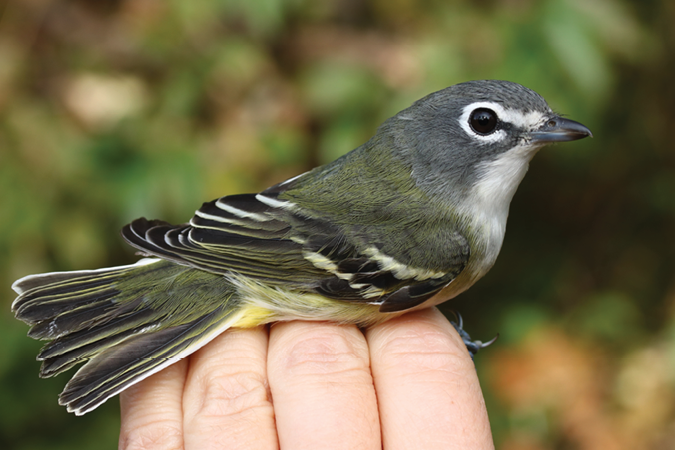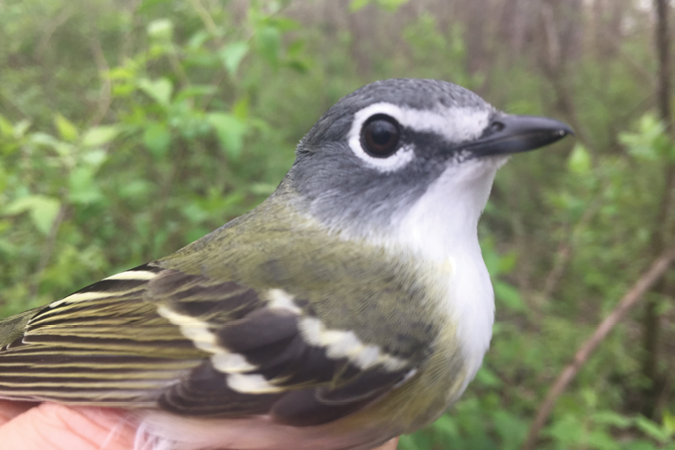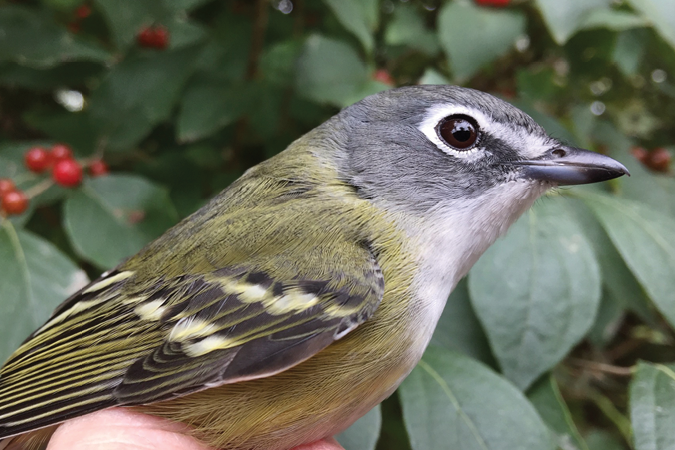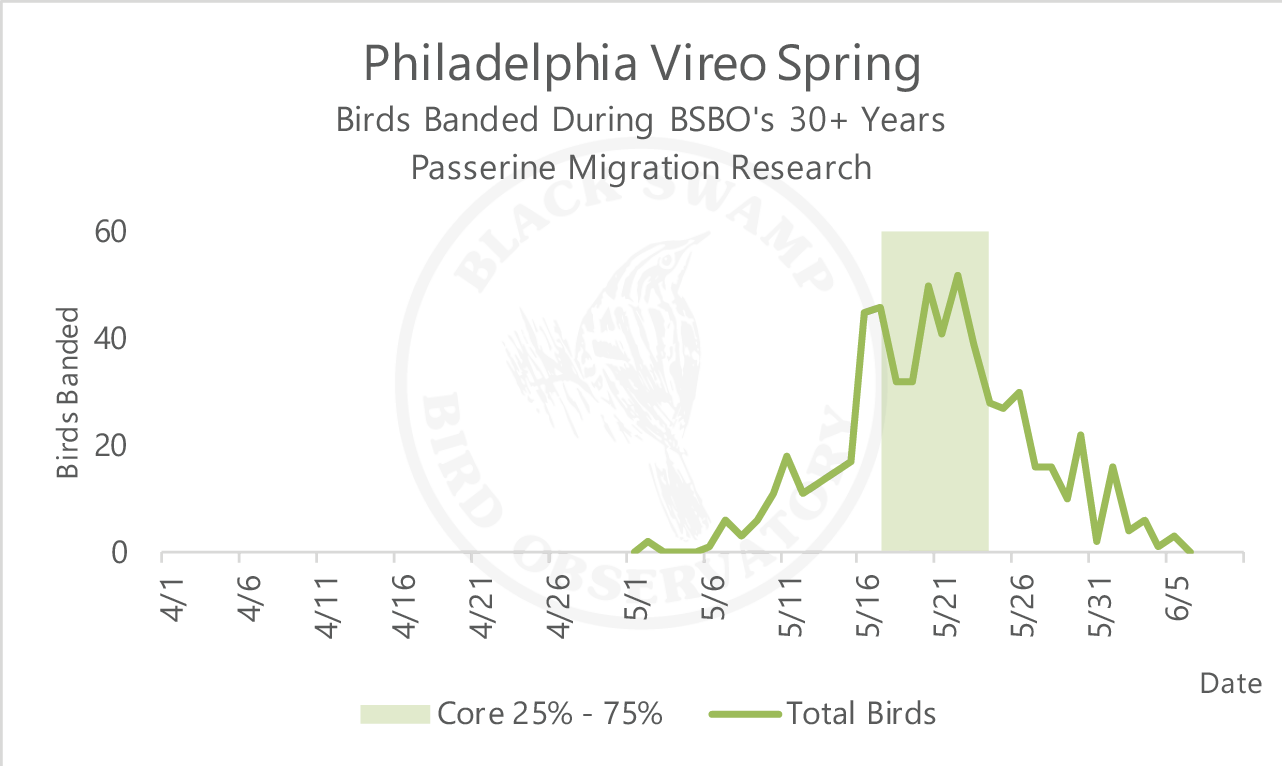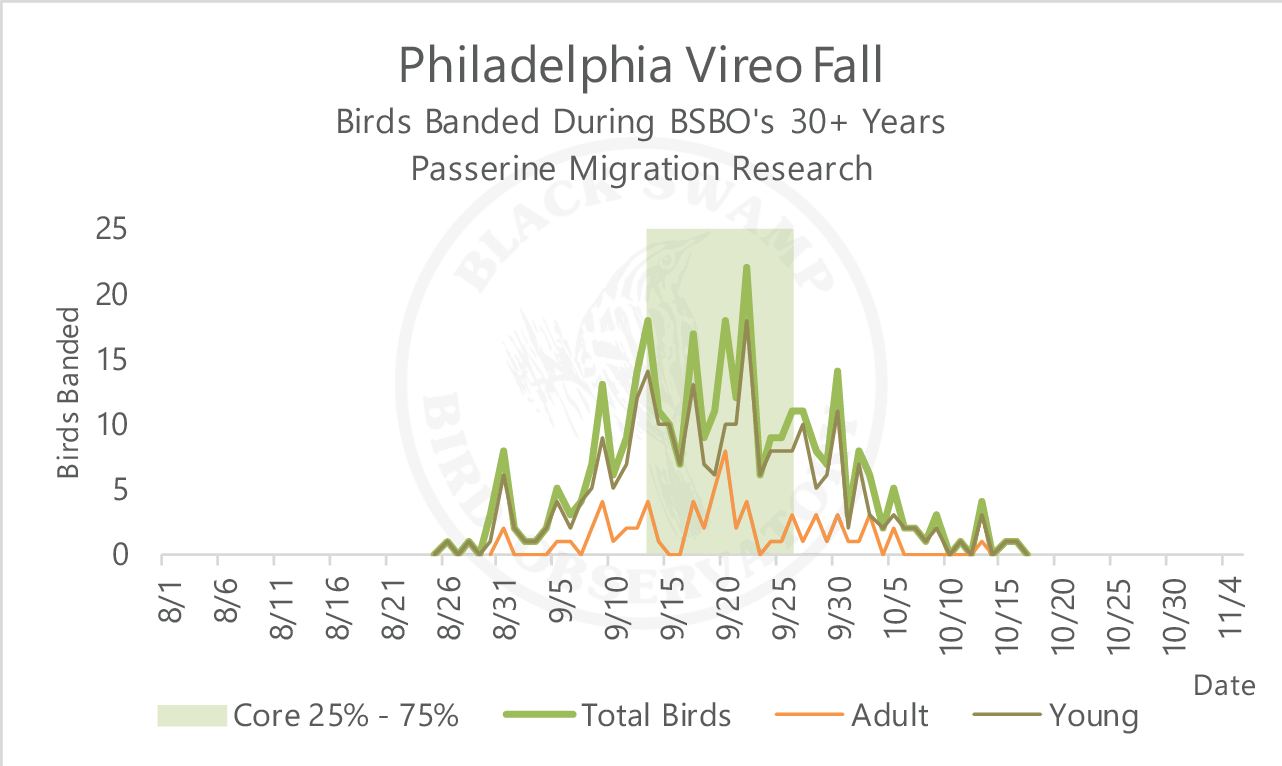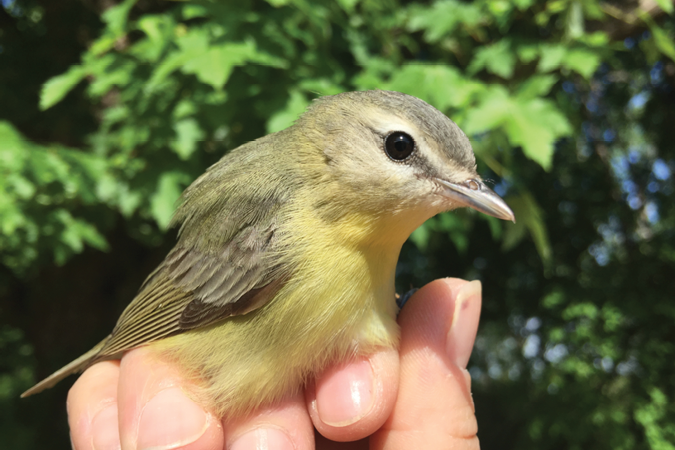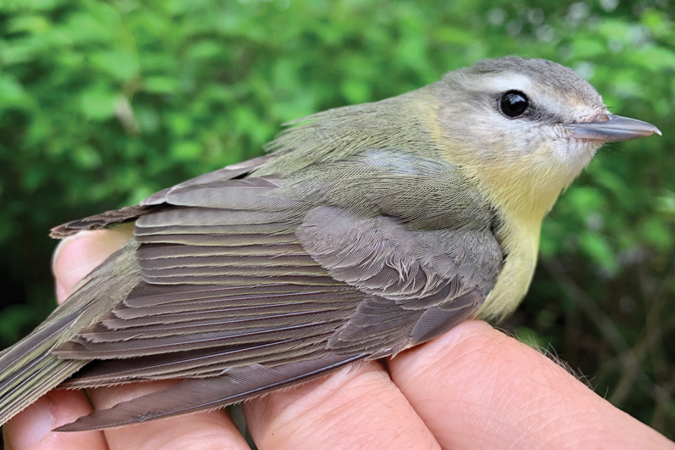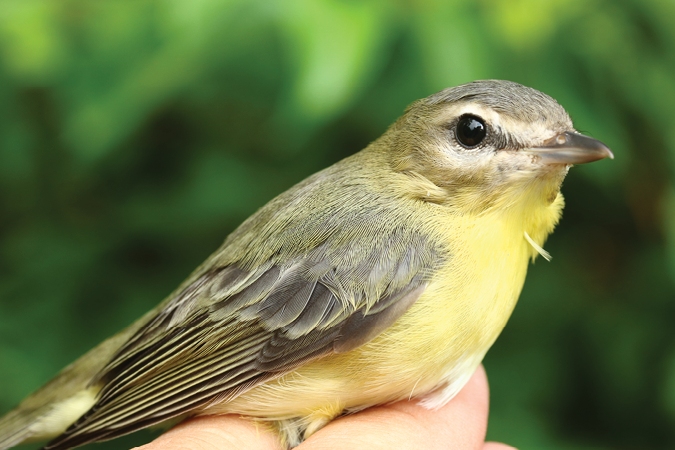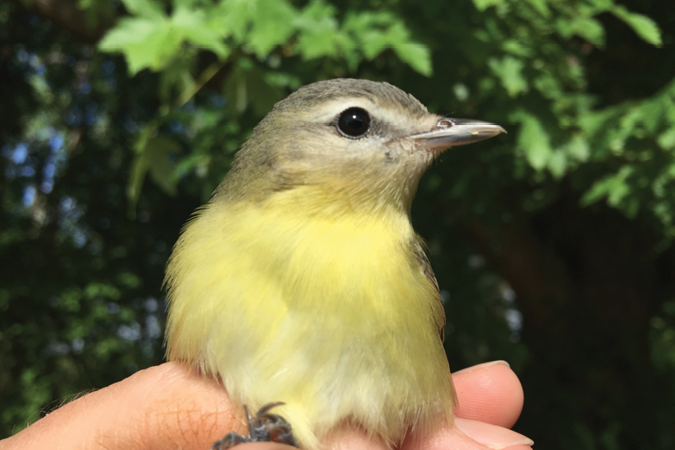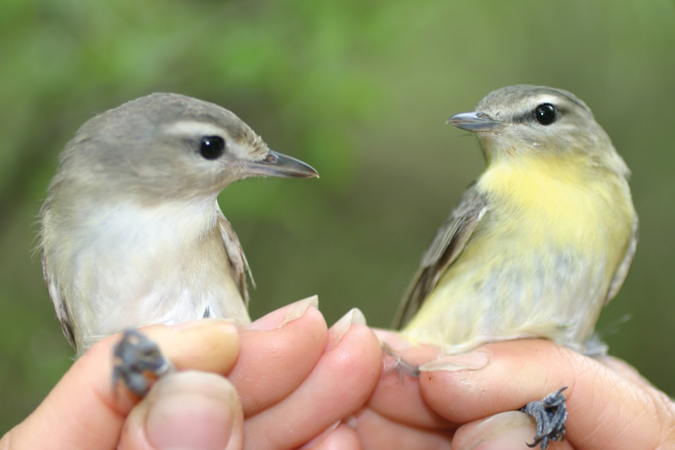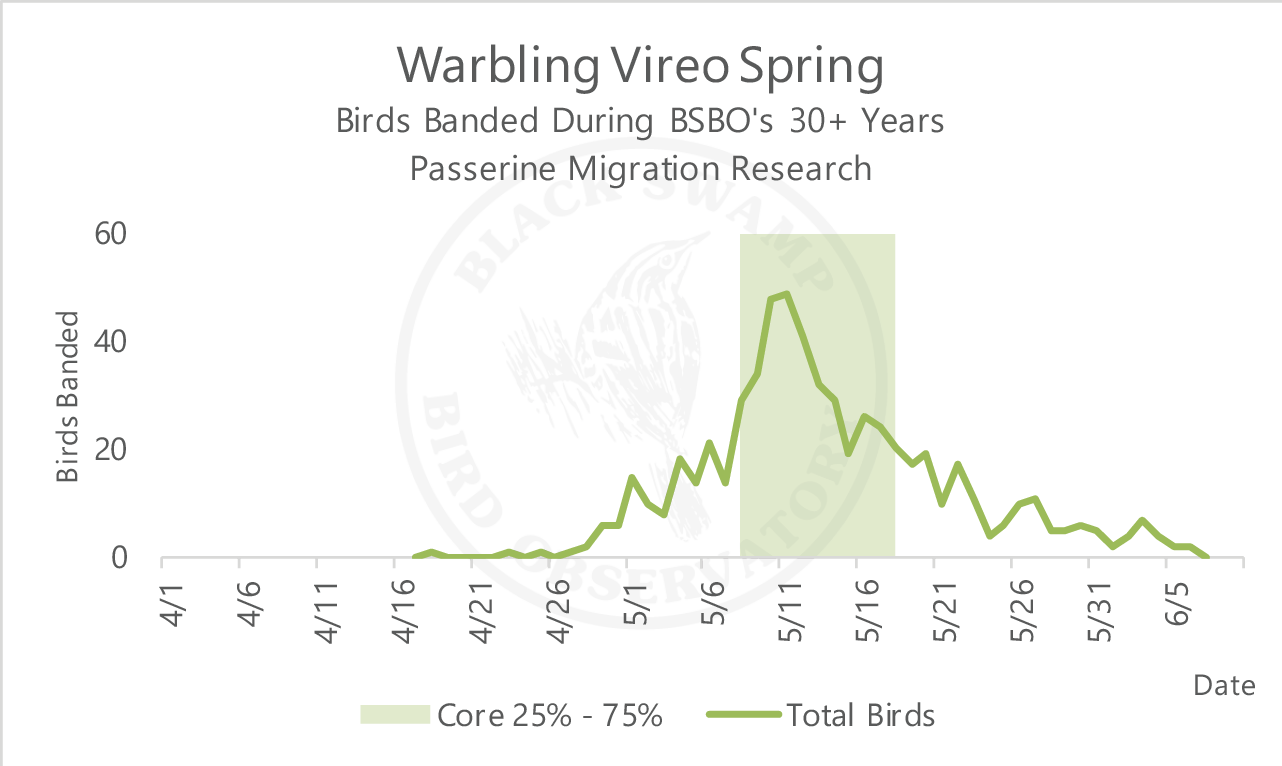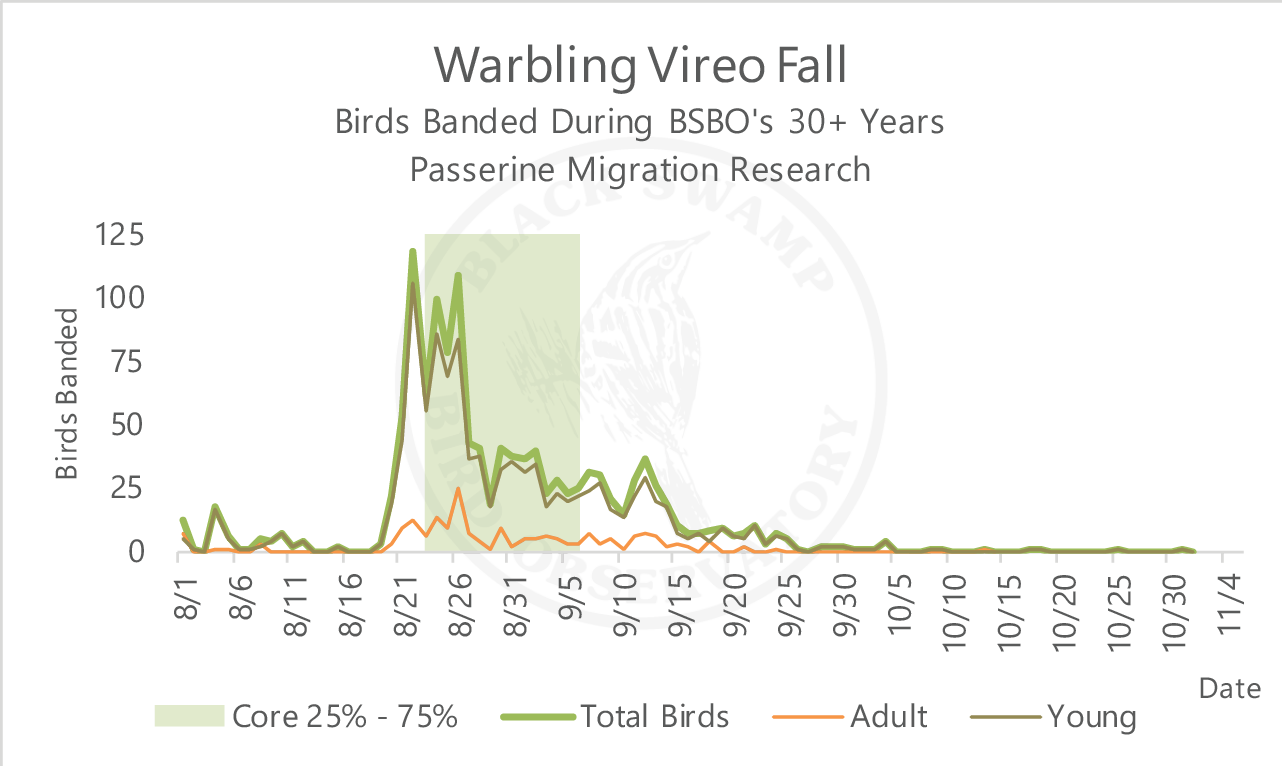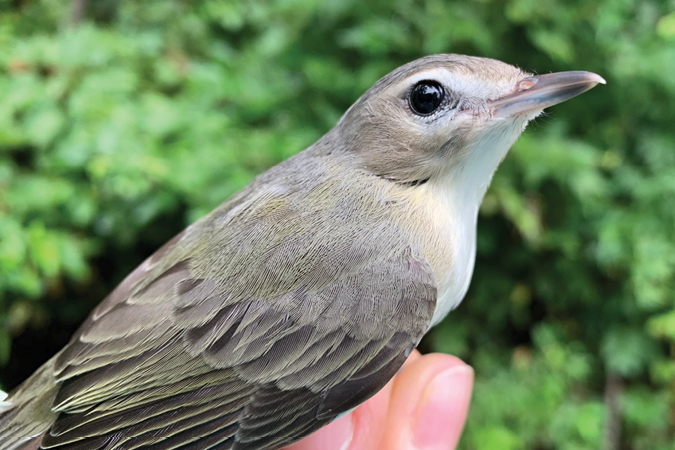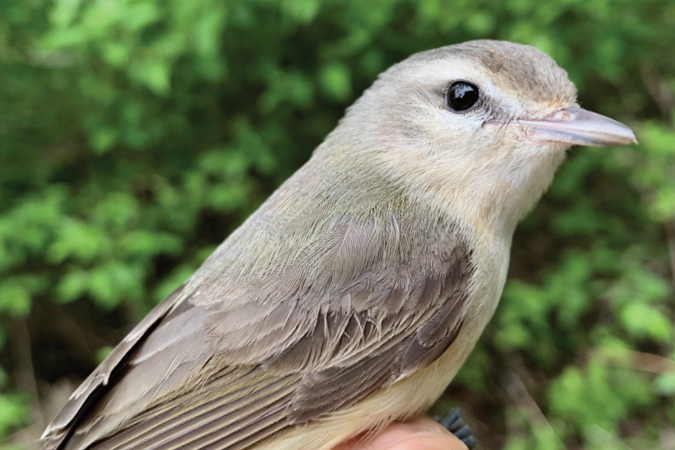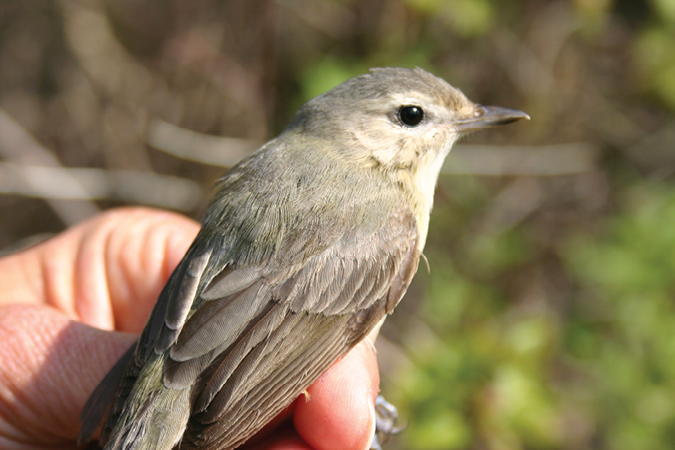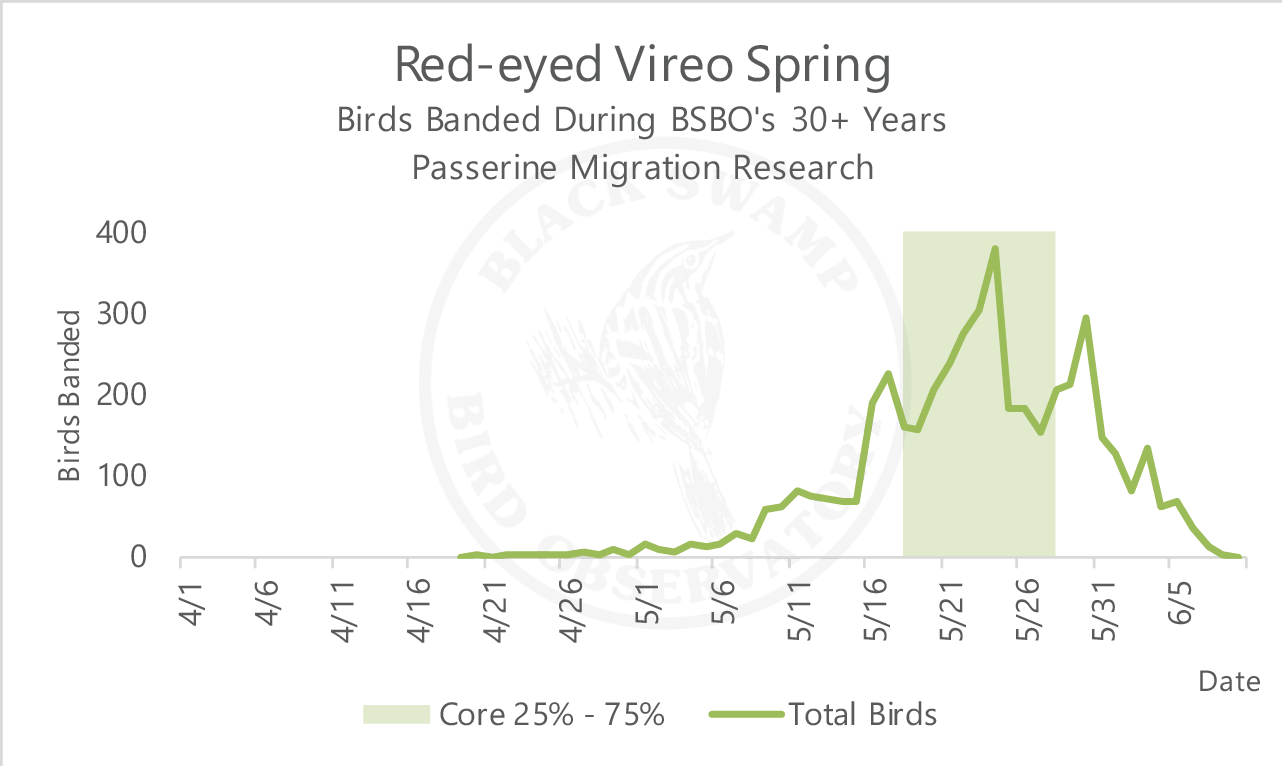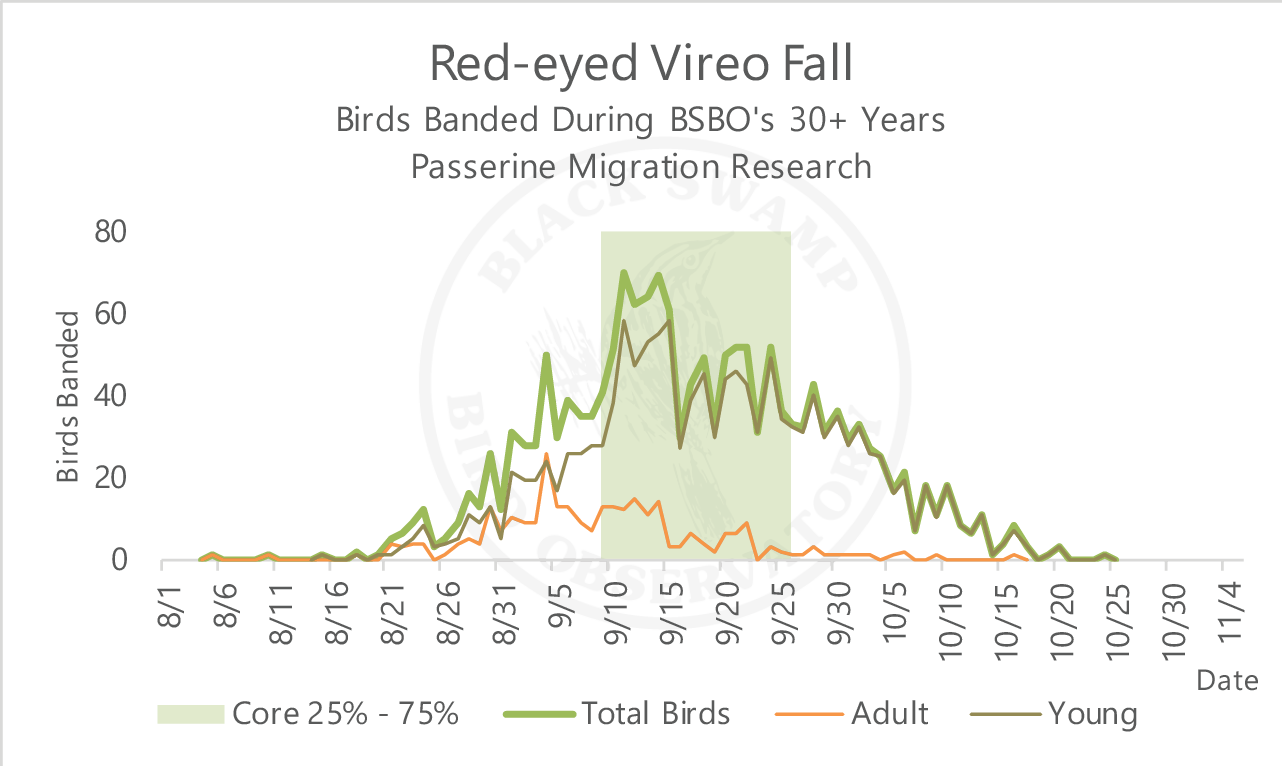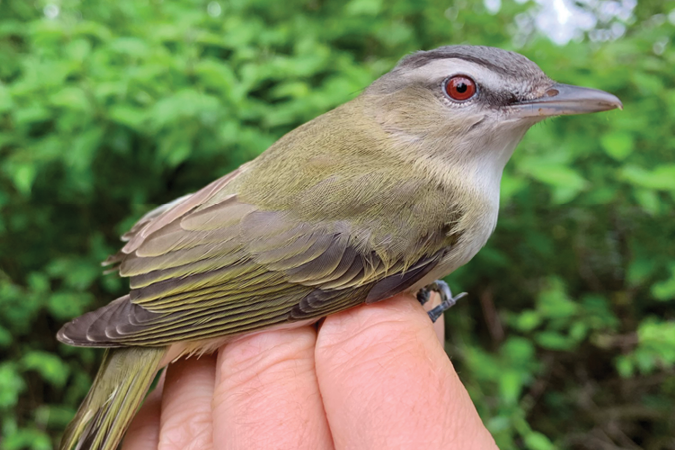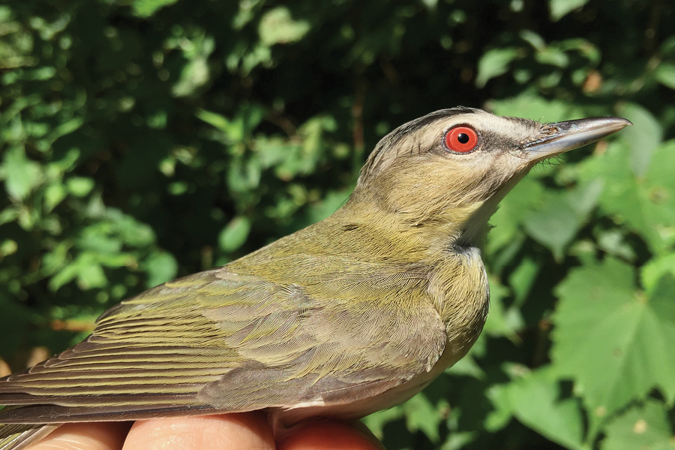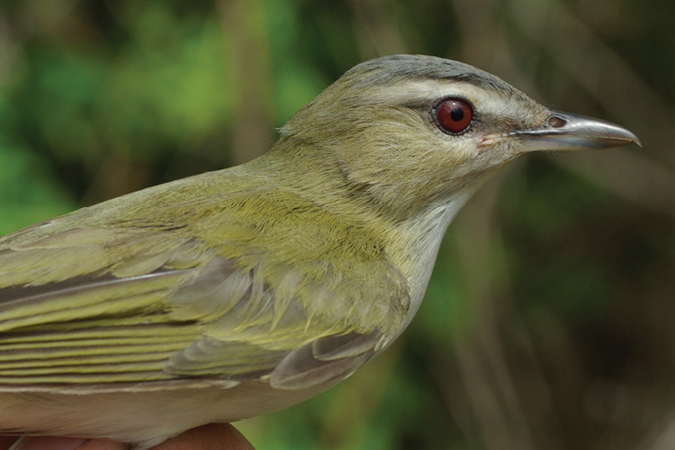Tyrant Flycatchers Tyrannidae
About tyrant flycatchers in nw ohio
Appropriate to their name, flycatchers can often be seen perching upright on an exposed branch in open areas or forests, before quickly sallying or flying out to catch an insect in midair. While a limited number occur in the US and Canada, the tyrant flycatchers are actually the largest family of birds in the Americas, with over 400 species. Many of the flycatchers occurring in Ohio are fairly plain with olive, yellow, gray, or black plumage, and are limited to eyerings and wingbars for adornment.
Breeding and migration habitat selection by flycatchers is varied but specific to species, and includes scrubby fields, forested rivers, and open forests. All but one of the flycatchers that occur in Ohio spend their winters in Central and South America. The Eastern Phoebe is the only flycatcher in the eastern US to have a year round status in some states and to winter along the Atlantic and Gulf coasts. Because of this, phoebes are the first to arrive in Ohio and the last to leave.
The majority of our other flycatchers occur predominantly in mid-May to early June when flying insects become readily available. Just as the phoebe is the first to arrive and last to leave, the other flycatchers that arrived late in spring are the first to leave in fall.
Due to identical plumages between male and female, and much overlap in size, limited sexing data are available for each of the flycatchers presented. However, analyzing each species’ timing graph in spring (when movements between males and females of most bird species are more apparent) reveals many of the flycatchers showing bimodal peaks, suggesting timing differences between the sexes as in other songbirds.
Breeding and migration habitat selection by flycatchers is varied but specific to species, and includes scrubby fields, forested rivers, and open forests. All but one of the flycatchers that occur in Ohio spend their winters in Central and South America. The Eastern Phoebe is the only flycatcher in the eastern US to have a year round status in some states and to winter along the Atlantic and Gulf coasts. Because of this, phoebes are the first to arrive in Ohio and the last to leave.
The majority of our other flycatchers occur predominantly in mid-May to early June when flying insects become readily available. Just as the phoebe is the first to arrive and last to leave, the other flycatchers that arrived late in spring are the first to leave in fall.
Due to identical plumages between male and female, and much overlap in size, limited sexing data are available for each of the flycatchers presented. However, analyzing each species’ timing graph in spring (when movements between males and females of most bird species are more apparent) reveals many of the flycatchers showing bimodal peaks, suggesting timing differences between the sexes as in other songbirds.
Great Crested Flycatcher Myiarchus crinitus
|
Alpha Code: GCFL Spanish: Copetón Viajero French: Tyran huppé Band Size: 1A ~ 1B NW Ohio Status: Migrant, Breeding Total Banded in Spring: 661 Average Banded in Spring: 22 Total Banded in Fall: 38 Average Banded in Fall: 1 |
Song: burry, two-part dawn song whee-ew and commonly heard loud, buzzy wheep call
Description: Brownish-olive above with yellow underparts. Gray face and throat. Rufous tail and wings. Male and female alike throughout the year. Spring Migration Timing: Second wave, with an initial surge of birds around May 10 and a steady movement of birds occurring May 11 through June 1. |
Fall Migration Timing: Mostly early migrant with the peak movement of total birds occurring August 21 through September 14.
Migration Habitat: Canopy-dweller of contiguous or open forests and groves; also forest edges and clearings; sometimes backyards. |
Eastern Kingbird Tyrannus tyrannus
|
Alpha Code: EAKI Spanish: Tirano de Dorso Negro French: Tyran tritri Band Size: 1B NW Ohio Status: Migrant, Breeding Total Banded in Spring: 148 Average Banded in Spring: 5 Total Banded in Fall: 59 Average Banded in Fall: 2 |
Song: sharp, buzzy dawn-song kit kit kit kit zeer and commonly heard buzzy, explosive zeet call
Description: Gray-black above with white underparts; head and tail blacker than back. White tail tip. Bright orange crown stripe often concealed. Male and female alike throughout the year. Spring Migration Timing: Primarily second wave, with birds first appearing in late April and early May, and the peak of total birds occurring May 12-27. |
Fall Migration Timing: Early and condensed with the majority of birds departing by September and the peak of total birds occurring
August 24-28. Migration Habitat: Wide variety of open habitats including forest edges and clearings, marsh edges, roadsides, and tallgrass prairies. |
Olive-sided Flycatcher Contopus cooperi
|
Alpha Code: OSFL Spanish: Pibí Boreal French: Moucherolle à côtés olive Band Size: 1B ~ 1 NW Ohio Status: Migrant-uncommon Total Banded in Spring: 54 Average Banded in Spring: 2 Total Banded in Fall: 6 Average Banded in Fall: <1 |
Song: emphatic quick, three-beers!
Description: Sooty gray above with a hint of olive and whitish underparts. Gray sides to breast resemble a vest. Male and female alike throughout the year. Spring Migration Timing: Mostly third wave, with occasional birds occurring in early May and the peak of total birds passing through May 18-29. |
Fall Migration Timing: Insufficient data to graph.
Migration Habitat: Semi-open areas near forests and forest edges (particularly near water), typically perching out in the open on a high, dead branch. Notes: Although a breeder well north of Ohio, OSFL seldom occur in the region during spring migration and occurrences are even rarer in fall. |
Eastern Wood-Pewee Contopus virens
|
Alpha Code: EAWP Spanish: Pibí Oriental French: Pioui de l’Est Band Size: 0A ~ 0 NW Ohio Status: Migrant, Breeding Total Banded in Spring: 960 Average Banded in Spring: 32 Total Banded in Fall: 433 Average Banded in Fall: 15 |
Song: loud, slurred pee-a-wee and loud, whistled purree
Description: Olive-gray above with white underparts sometimes tinted yellow. Dusky-white sides to breast mildly resembling a vest. Diffuse white wingbar. Male and female alike throughout the year. Spring Migration Timing: Third wave, with birds first appearing in early May and the peak of total birds occurring May 18-28. |
Fall Migration Timing: Fairly prolonged for a flycatcher with birds occurring from August into early October and the peak of total birds occurring September 9-26.
Migration Habitat: Open forests and edges around meadows, ponds, and forest clearings. |
Yellow-bellied Flycatcher Empidonax flaviventris
|
Alpha Code: YBFL Spanish: Mosquero de Vientre Amarillo French: Moucherolle à ventre jaune Band Size: 0A ~ 0 NW Ohio Status: Migrant Total Banded in Spring: 3,345 Average Banded in Spring: 112 Total Banded in Fall: 607 Average Banded in Fall: 21 |
Song: flat, abrupt che-bunk and a quick whistled tu-wee
Description: Yellow-olive above with yellowish underparts. Lemon-yellow to white eyering and wingbars. Male and female alike throughout the year. Spring Migration Timing: Third wave, with birds first appearing in mid-May and the peak of total birds occurring May 23 through June 1. |
Fall Migration Timing: Sudden appearance around August 20 with birds lingering into early October, and the peak of total bird movement occurring August 27 through September 17.
Migration Habitat: Low- to mid-level forager of shaded areas in forests, undergrowth, and edges. |
Acadian Flycatcher Empidonax virescens
|
Alpha Code: ACFL Spanish: Mosquero Verdoso French: Moucherolle vert Band Size: 0A ~ 0 NW Ohio Status: Migrant, Breeding-local Total Banded in Spring: 828 Average Banded in Spring: 28 Total Banded in Fall: 19 Average Banded in Fall: <1 |
Song: explosive peet-seet or piz-za with the second syllable accented
Description: Pale olive-green above with whitish underparts. Pale purple-tinged upper mandible and legs. Two whitish wingbars and whitish eyering. Male and female alike throughout the year. Spring Migration Timing: Third wave, with birds first appearing in mid-May and the peak of total birds occurring May 22-31. |
Fall Migration Timing: Low and sporadic with birds encountered late August through early October, and the bulk of birds occurring September 4-30.
Migration Habitat: Shaded forests, favoring wet and swampy woods, and those near rivers and streams. Will move into the understory of drier forests to forage. Notes: NW Ohio is at the very northern edge of ACFL breeding range. Due to this, very few birds are banded in fall. |
Traill's Flycatcher (Willow and Alder) Empidonax traillii / alnorum
|
Alpha Code: TRFL, WIFL, ALFL Spanish: Mosquero de Traill, Mosquero Saucero, Mosquero Ailero French: Moucherolle de Traill, Moucherolle des saules, Moucherolle des aulnes Band Size: 0A ~ 0 NW Ohio Status: Migrant, Breeding (WIFL) Total Banded in Spring: 8,954 Average Banded in Spring: 198 Total Banded in Fall: 173 Average Banded in Fall: 6 |
Song WIFL: wheezy fitz-bew
Song ALFL: burry fee-bee-o with the last note often inaudible, or free-beer! Description: WIFL and ALFL alike in appearance. Brownish-olive above with whitish underparts variably tinted yellow and dusky breast. Two whitish wingbars. Whitish eyering is variably thin to absent. Male and female alike throughout the year. Spring Migration Timing: Third wave, with birds first appearing in mid-May and the peak of total birds occurring May 22-31. |
Fall Migration Timing: Early, with most birds departing by August. Lingerers depart by October, with the most movement of these late birds occurring August 21 through September 6.
Migration Habitat: Brushy clearings and thickets, also along woodland edges. Willow preferring willows and potentially dry areas. Alder preferring alders and wet areas near marshes, streams, and ponds. Notes: WIFL and ALFL are only reliably identified by voice. While WIFL breed in Ohio and ALFL mostly breed north of Ohio, during migration, non-vocal birds could be either species regardless of habitat and should be listed as Traill’s Flycatcher, the name the two species shared when they were formerly considered one species. |
Least Flycatcher Empidonax minimus
|
Alpha Code: LEFL Spanish: Mosquero Mínimo French: Moucherolle tchébec Band Size: 0A ~ 0 NW Ohio Status: Migrant, Breeding-rare Total Banded in Spring: 2,975 Average Banded in Spring: 99 Total Banded in Fall: 210 Average Banded in Fall: 7 |
Song: short, dry che-bec accented on the second syllable
Description: Olive-gray above with whitish underparts and dusky breast. Two whitish wingbars. Conspicuous white eyering. Male and female alike throughout the year. Spring Migration Timing: Earlier than other Empid flycatchers, appearing in the second wave with the peak of total birds occurring May 10-19. |
Fall Migration Timing: Sudden movement around August 20 with most birds departing by October. Peak movement of total birds occurring August 26 through September 15.
Migration Habitat: Open woods and shade trees, typically along forest edges and clearings, and occasionally backyards. |
Eastern Phoebe Sayornis phoebe
|
Alpha Code: EAPH Spanish: Papamoscas Fibí French: Moucherolle phébi Band Size: 0 ~ 1 NW Ohio Status: Migrant, Breeding Total Banded in Spring: 152 Average Banded in Spring: 5 Total Banded in Fall: 670 Average Banded in Fall: 23 |
Song: clear fee-bee with a raspy end
Description: Brownish-gray above with whitish underparts; head typically the darkest feature. Some birds in fall may show whitish wingbars and a yellow tint to the belly. Male and female alike throughout the year. Spring Migration Timing: Early, with birds first appearing in March and heavy movement ending by late April. Peak of total bird movement occurring April 10-22. |
Fall Migration Timing: Fairly extensive with heavy movement in late August and lower consistent movement into late October. Bulk of total birds occurring August 27 through
October 1. Migration Habitat: Variety of brushy habitats in clearings and along forest edges, particularly near water, but may also be found in backyards. Notes: As a short-distance migrant (especially compared to other flycatchers) EAPH can appear very late in winter (before “spring” migration) and linger into early winter (after “fall” migration). |
Vireos Vireonidae
About vireos in nw ohio
Although similar in appearance to the warblers, vireos are stocky songbirds easily identifiable by their blue-gray legs and silvery bill with a small hook at the end. While not as heavily patterned or bright as other songbirds, vireos show much variation in eye color, plumage colors, and facial patterns. They are also quite vocal - even during summer - but because of their tendency to forage in dense or canopy vegetation, vireos are heard much more frequently than seen.
None of these hidden songsters winter in Ohio. Some may travel the short distance the Gulf states, but many others continue on to Central and South America. During migration in Northwest Ohio, vireos can appear in a variety of forested habitats and nearby clearings, preferring to move along the periphery of tree lines.
Due to identical plumages between male and female, and much overlap in size, limited sexing data are available for each of the vireos presented. However, inspecting each species’ timing graph in spring (when movements between males and females of most bird species are more apparent) reveals some of the vireos showing bimodal peaks, suggesting timing differences between the sexes as in other songbirds.
None of these hidden songsters winter in Ohio. Some may travel the short distance the Gulf states, but many others continue on to Central and South America. During migration in Northwest Ohio, vireos can appear in a variety of forested habitats and nearby clearings, preferring to move along the periphery of tree lines.
Due to identical plumages between male and female, and much overlap in size, limited sexing data are available for each of the vireos presented. However, inspecting each species’ timing graph in spring (when movements between males and females of most bird species are more apparent) reveals some of the vireos showing bimodal peaks, suggesting timing differences between the sexes as in other songbirds.
White-eyed Vireo Vireo griseus
|
Alpha Code: WEVI Spanish: Vireo de Ojo Blanco French: Viréo aux yeux blancs Band Size: 0 ~ 0A NW Ohio Status: Migrant, Breeding-local Total Banded in Spring: 347 Average Banded in Spring: 12 Total Banded in Fall: 30 Average Banded in Fall: 1 |
Song: mix of various emphatic jumbles, typically ending with a sharp note pick-up-a-real-chick!
Description: Overall olive-gray above with whitish underparts and yellow flanks. Two notable white wingbars. Adult birds sport a white eye surrounded by yellow “spectacles.” Although a temporary misnomer, young birds in fall - and occasionally in spring - have a dark gray eye. Male and female alike throughout the year. Spring Migration Timing: Along with other overflight species, WEVI begin to arrive in mid- to late April, with the majority passing through between April 29 and May 14. |
Fall Migration Timing: Low and sporadic. An uncommon fall migrant, but the most that do pass through can arrive anywhere between August 30 and October 12.
Migration Habitat: Often found low in scrubby thickets and woodland edges. Notes: At the very northern edge of their breeding range, most WEVI encountered in NW Ohio in spring are considered overflights. However, localized breeding does occur in the region and not all birds along the lake shore may be accidental overflights. |
Yellow-throated Vireo Vireo flavifrons
|
Alpha Code: YTVI Spanish: Vireo de Garganta Amarilla French: Viréo à gorge jaune Band Size: 1 NW Ohio Status: Migrant, Breeding Total Banded in Spring: 55 Average Banded in Spring: 2 Total Banded in Fall: 20 Average Banded in Fall: <1 |
Song: relaxed assortment of hoarse phrases zeyoo… breeyoowit… wheeyay…
Description: Olive-green above with gray towards the base of the tail, white below, and a notable amount of yellow on the throat and breast. Dark wings with white wingbars. Dark eyes are surrounded by yellow “spectacles.” Male and female alike throughout the year. Spring Migration Timing: Primarily second wave, with birds first arriving in late April, and the peak of total birds occurring May 3-14. |
Fall Migration Timing: Uncommon in fall, but numbers tend to peak from September 11-26.
Migration Habitat: A canopy forager of oaks and other woodland settings. Notes: Data may not be truly reflective of the number of birds passing through the region as YTVI tend to remain in the canopy, outside the range of capture. |
Blue-headed Vireo Vireo solitarius
|
Alpha Code: BHVI Spanish: Vireo Solitario French: Viréo à tête bleue Band Size: 1 ~ 0 NW Ohio Status: Migrant, Breeding-local Total Banded in Spring: 671 Average Banded in Spring: 22 Total Banded in Fall: 306 Average Banded in Fall: 11 |
Song: clear, whistled notes given at a spaced-out rhythm suweet… seeoo… seeoowip…
Description: Olive-green above with whitish underparts and yellow-green sides. White wingbars. Blue-gray head with a contrasting white throat, and white “spectacles” envelop a dark eye. Male and female alike throughout the year. Spring Migration Timing: Second wave, with many beginning to appear in mid-April’s first wave, and the peak of total birds occurring May 2-12. |
Fall Migration Timing: Fairly late, with birds appearing by late August and early September, and peak numbers occurring from September 27 through October 12.
Migration Habitat: Mid-level to canopy forager of various forested areas including backyards. |
Philadelphia Vireo Vireo philadelphicus
|
Alpha Code: PHVI Spanish: Vireo de Filadelfia French: Viréo de Philadelphie Band Size: 0 ~ 0A NW Ohio Status: Migrant Total Banded in Spring: 750 Average Banded in Spring: 25 Total Banded in Fall: 391 Average Banded in Fall: 13 |
Song: quick, clear whistles, highly similar to Red-eyed Vireo see-me? here-I-am! up-here. see-me? but typically higher pitched with longer pauses
Description: Olive-gray above with notable yellow below, brightest on the throat and breast. White eyebrow contrasts with dark lores between the eye and base of the bill. Male and female alike throughout the year. Spring Migration Timing: Late second into third wave, with peak numbers occurring May 17-24. |
Fall Migration Timing: Many begin to appear in late August, with peak numbers occurring September 13-26.
Migration Habitat: Mid- to canopy-level forager of various wooded areas. Notes: Can be quite similar to WAVI, but note the darker lores and more defined facial pattern; extensive, centered yellow; and compact appearance. In spring and fall, peak numbers occur later than WAVI. |
Warbling Vireo Vireo gilvus
|
Alpha Code: WAVI Spanish: Vireo Gorjeador French: Viréo mélodieux Band Size: 0 ~ 1 NW Ohio Status: Migrant, Breeding Total Banded in Spring: 754 Average Banded in Spring: 25 Total Banded in Fall: 1,322 Average Banded in Fall: 46 |
Song: fast, high-intensity warble of throaty notes
Description: Drab gray above with whitish underparts. Pale face with white eyebrow and faint lores. Some birds may have a pale yellow wash below, usually restricted to the sides. Male and female alike throughout the year. Spring Migration Timing: Second wave, with birds arriving notably by May 1, and peak numbers occurring from May 8-18. |
Fall Migration Timing: Birds make an obvious appearance by late August, with peak numbers showing from August 21 through September 6.
Migration Habitat: This mid- to canopy-level forager utilizes a wide range of wooded areas including urban parks and backyards. Notes: Although often confused with PHVI, WAVI are generally much paler and uniform in color, and with a more elongated head profile. In spring and fall, peak numbers of WAVI occur before PHVI. |
Red-eyed Vireo Vireo olivaceus
|
Alpha Code: REVI Spanish: Vireo de Ojo Rojo French: Viréo aux yeux rouges Band Size: 1 ~ 0 NW Ohio Status: Migrant, Breeding Total Banded in Spring: 5,204 Average Banded in Spring: 173 Total Banded in Fall: 1,846 Average Banded in Fall: 64 |
Song: clear whistled phrases similar to Philadelphia Vireo see-me? here-I-am! up-here. see-me? but lower pitched and quicker
Description: Olive-green above with whitish underparts. Dark cap and eyeline border a white eyebrow. Adults with the namesake red eye, and younger birds showing a brown to brick-red eye. Male and female alike throughout the year. Spring Migration Timing: Largely third wave, with notable numbers reaching NW Ohio May 17-28. |
Fall Migration Timing: Relatively prolonged movement starting in late August through mid-October, with peak numbers occurring September 10-26.
Migration Habitat: A canopy dweller of deciduous woodlands. Due to the extensive leaf cover of late May, REVI are often heard rather than seen. |
